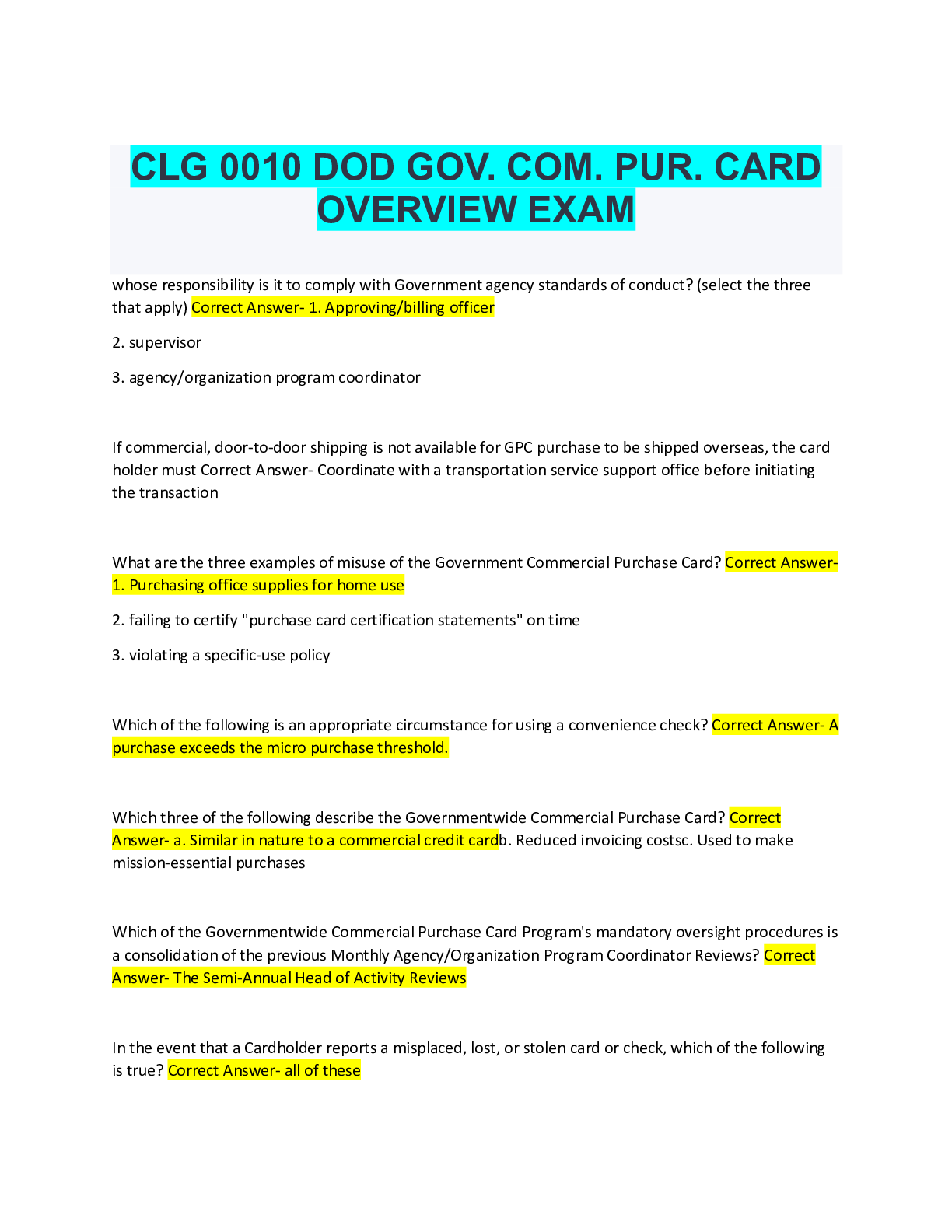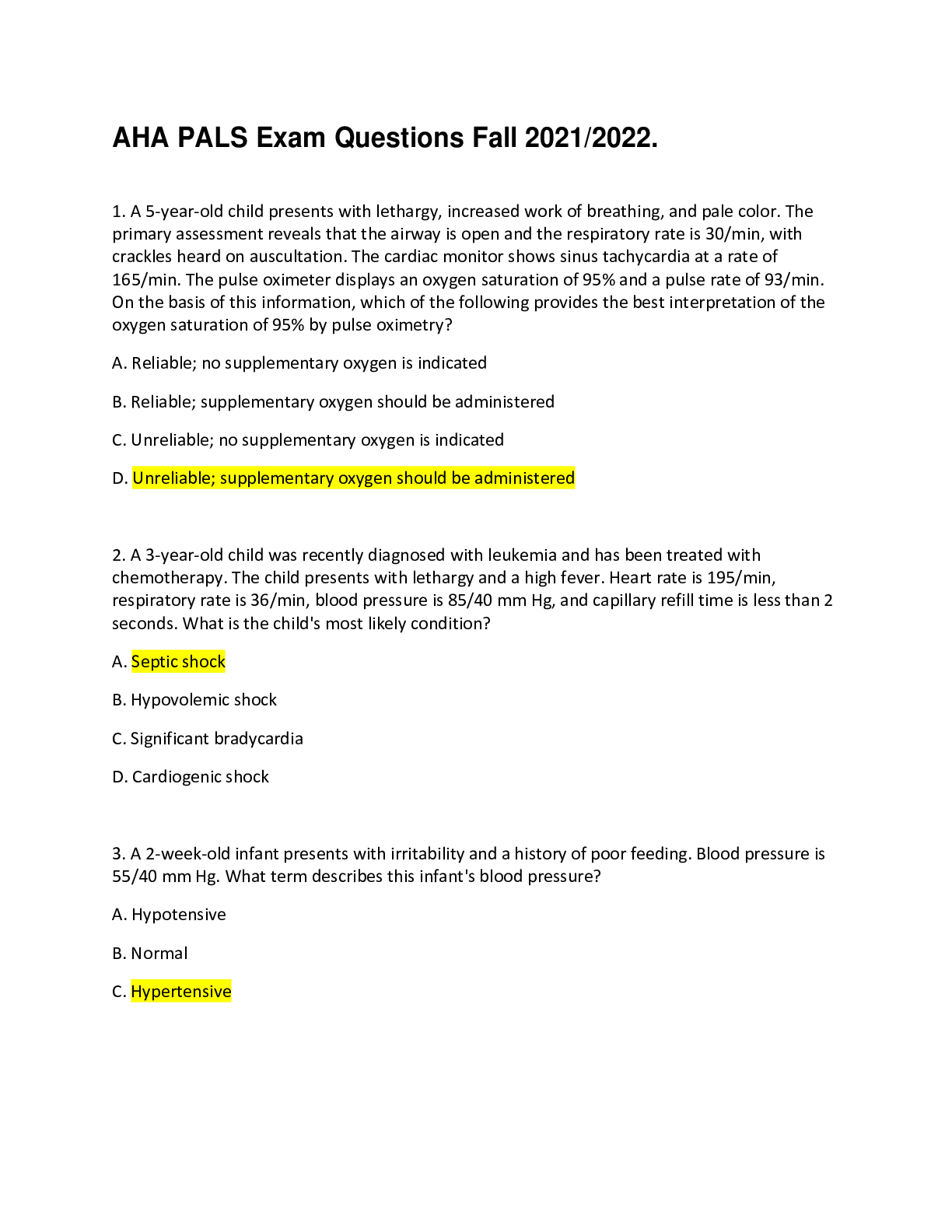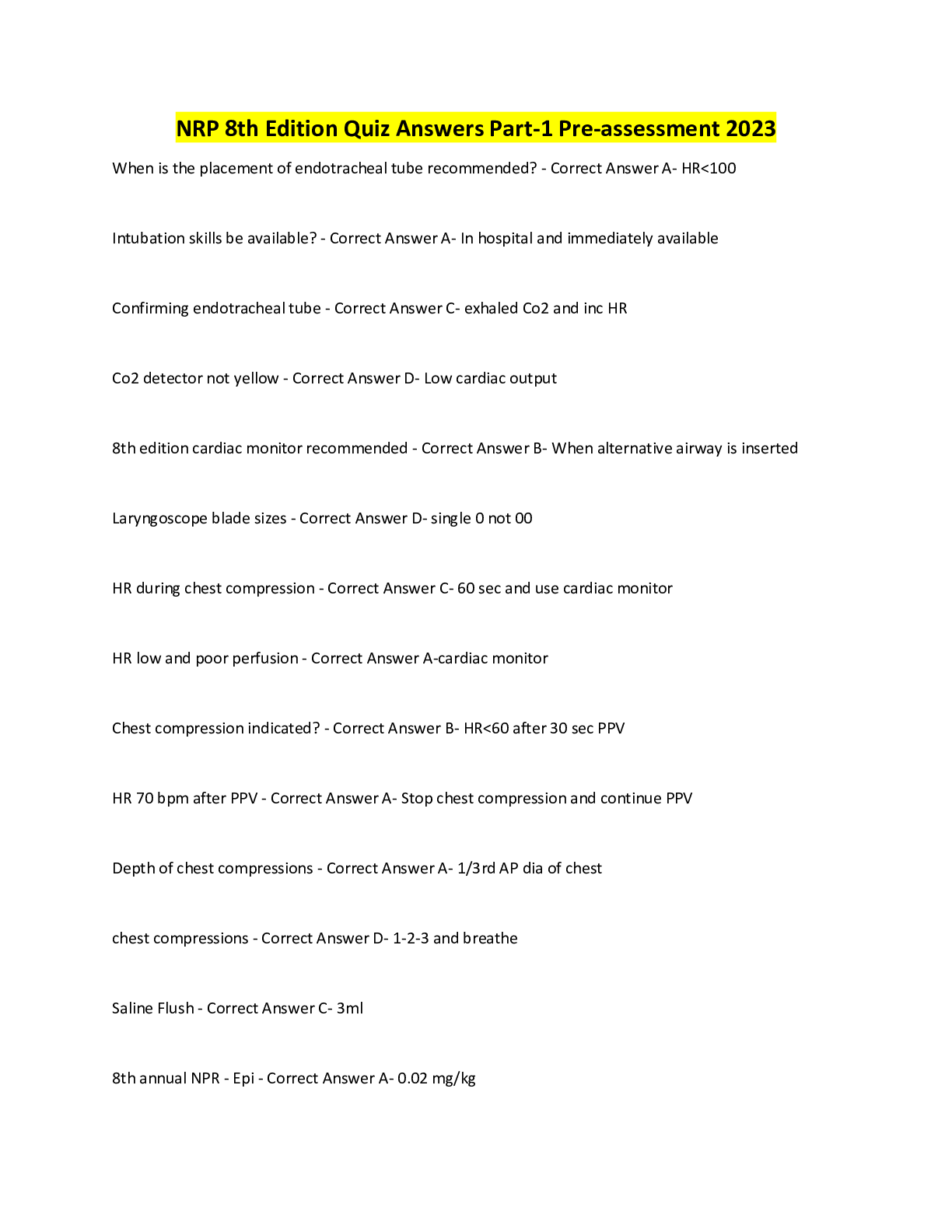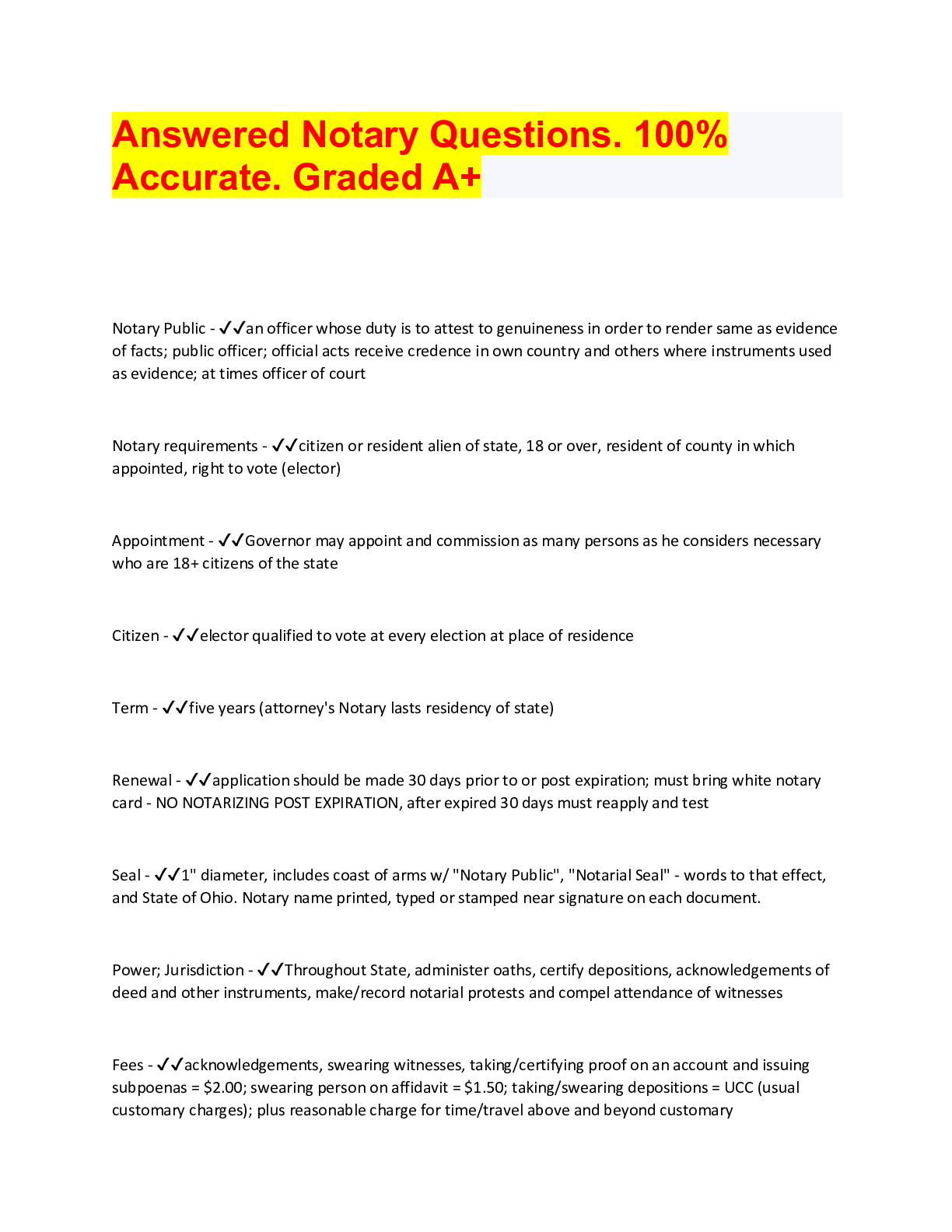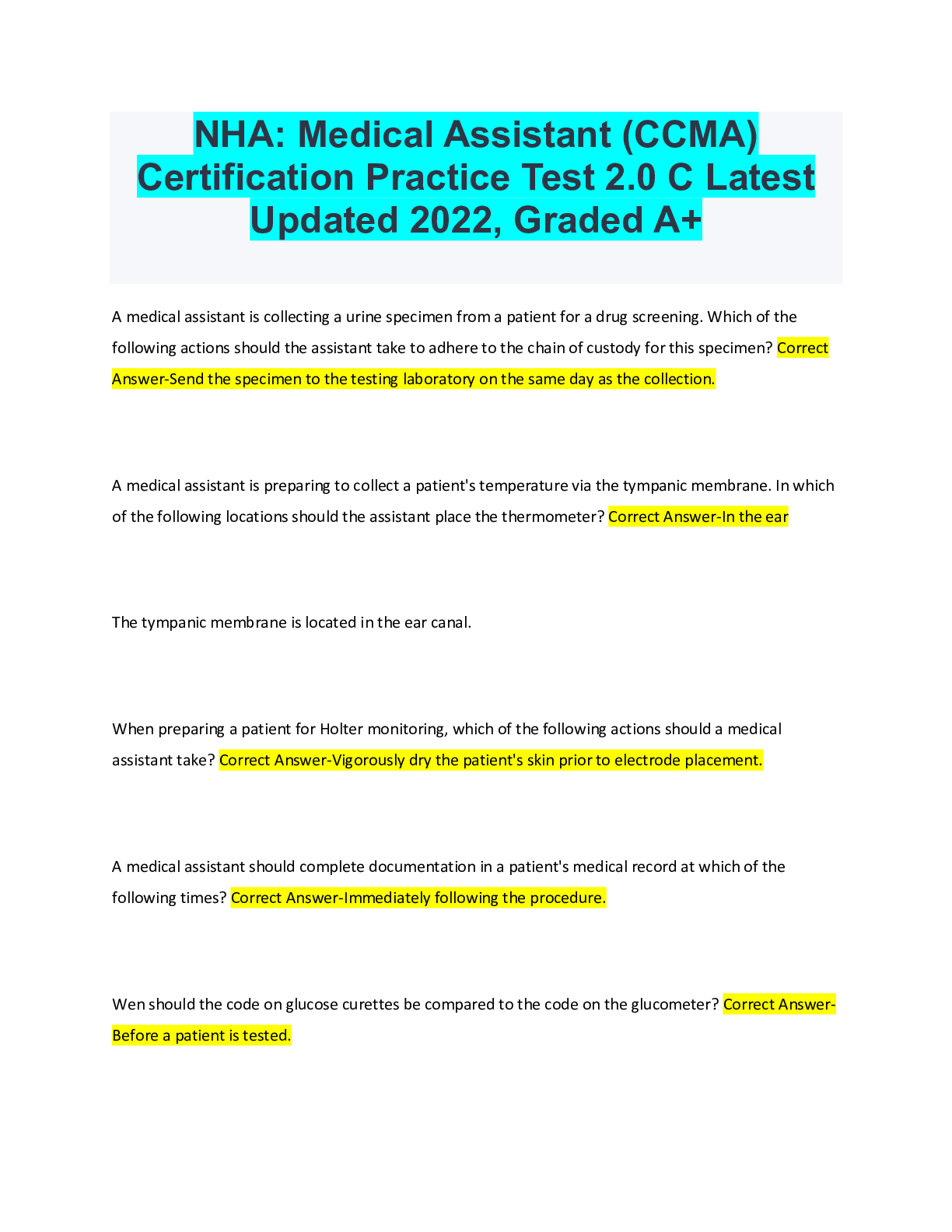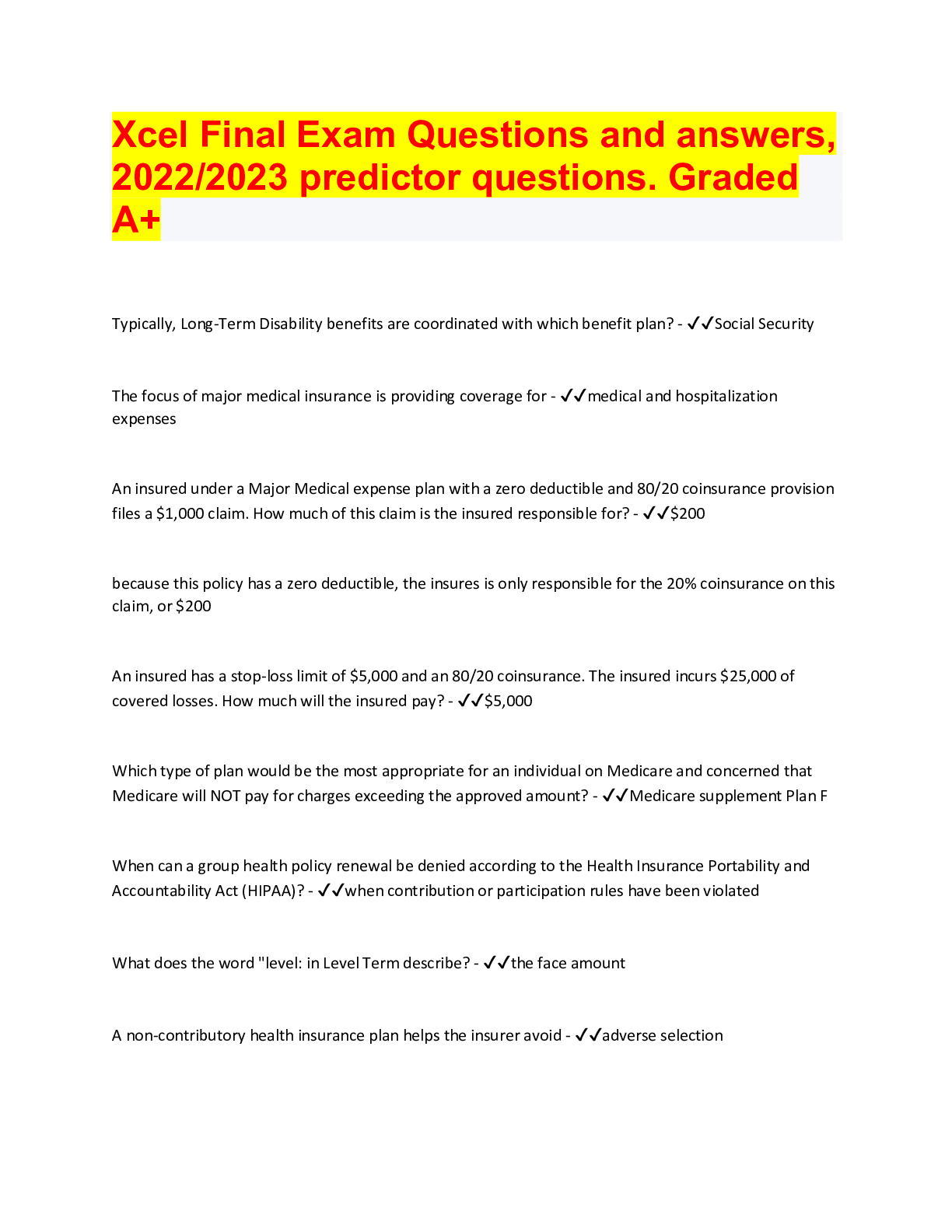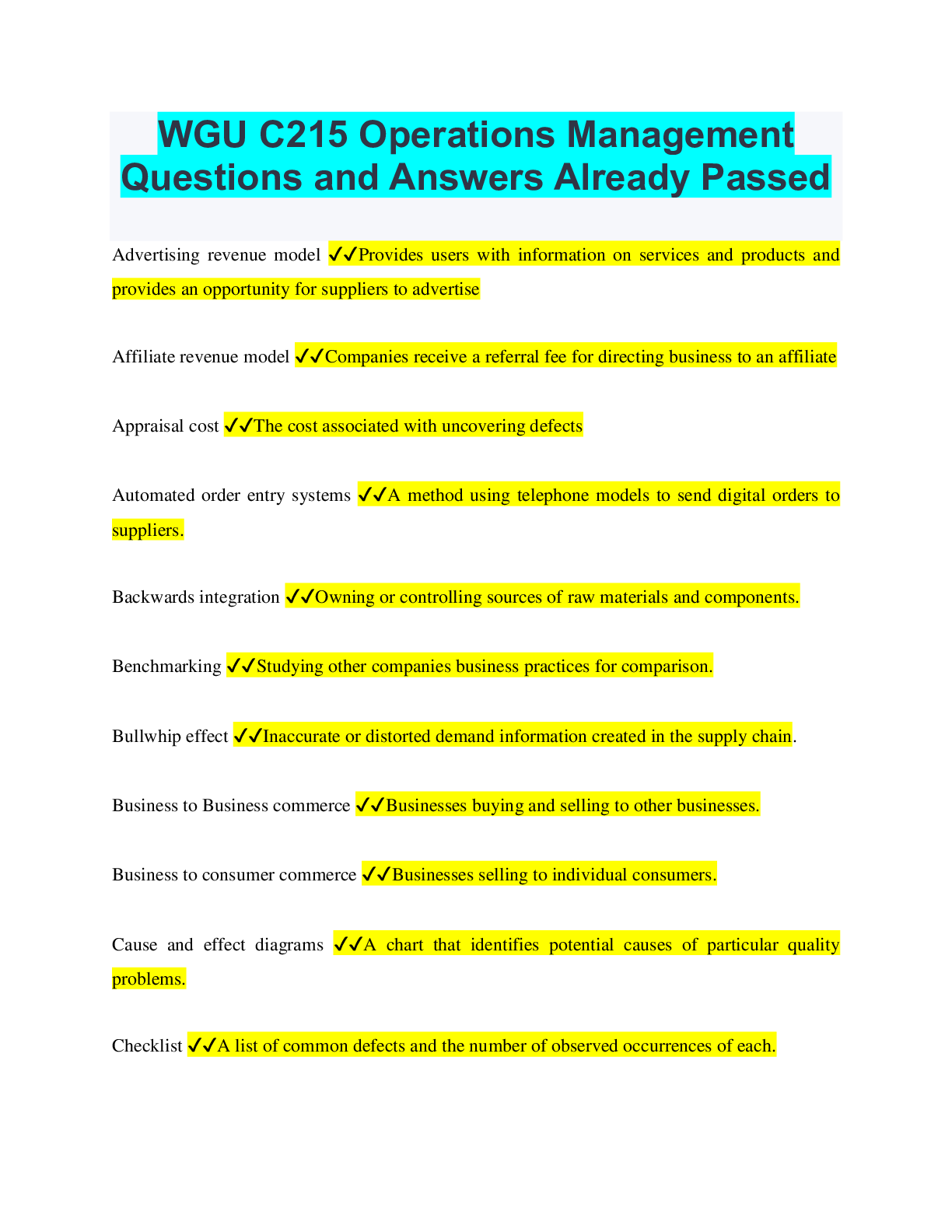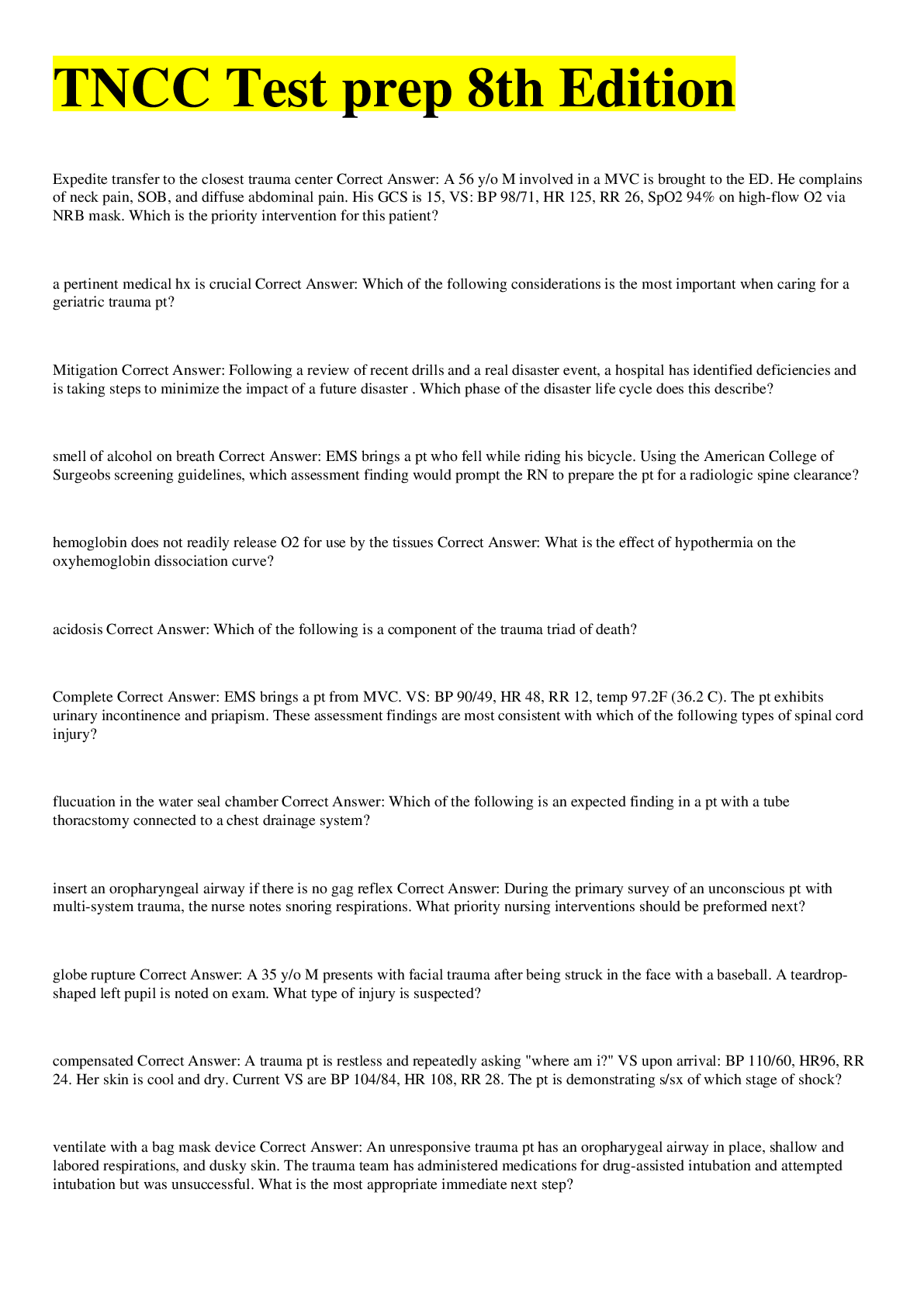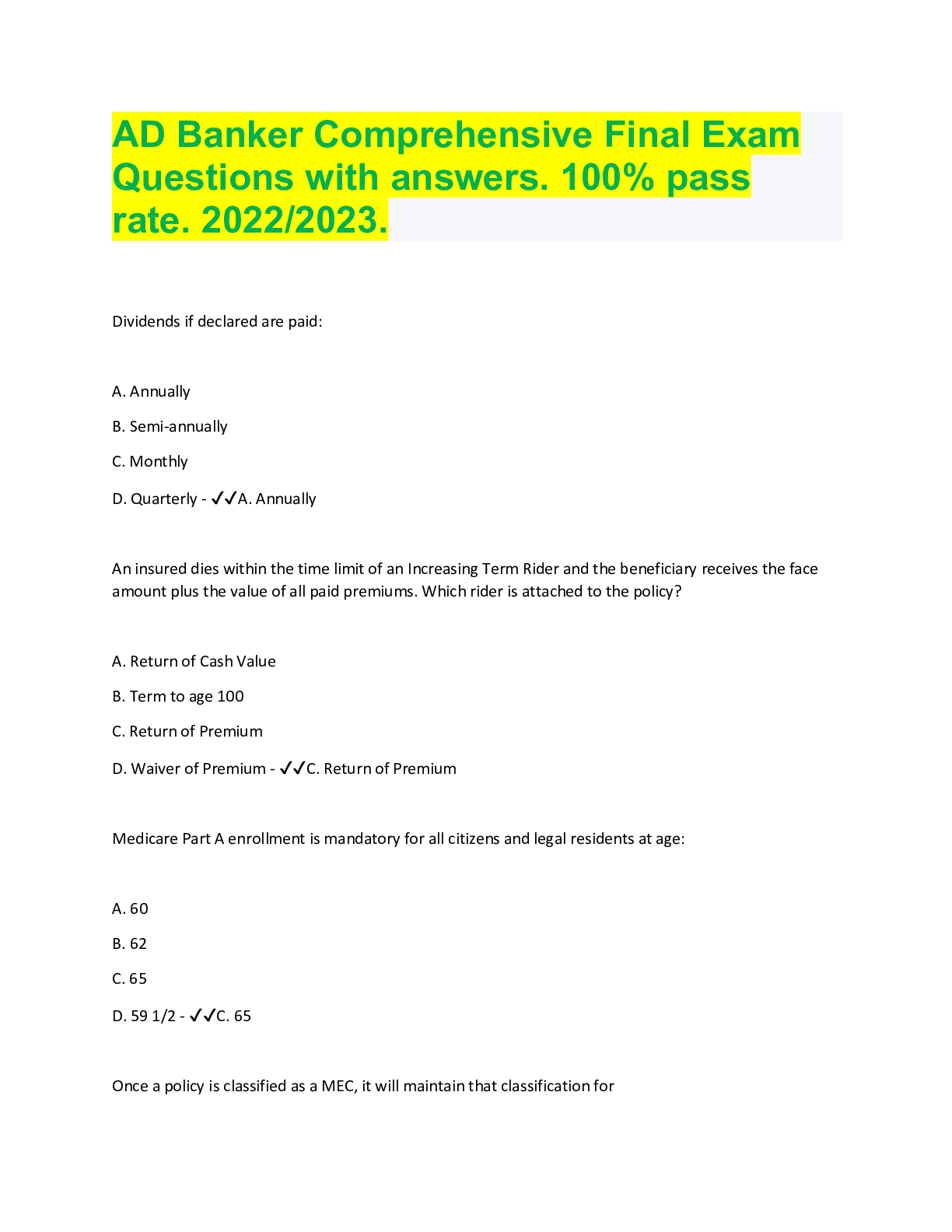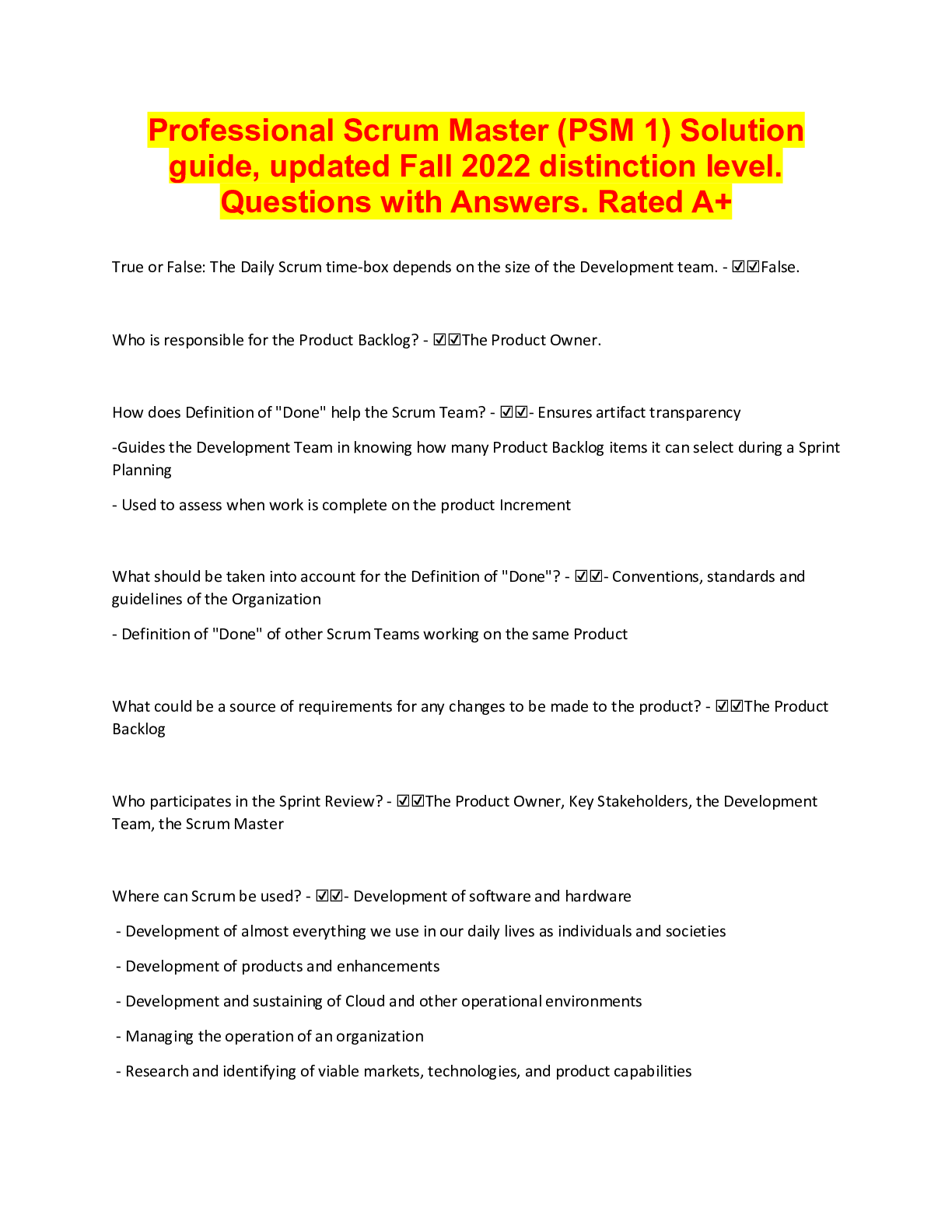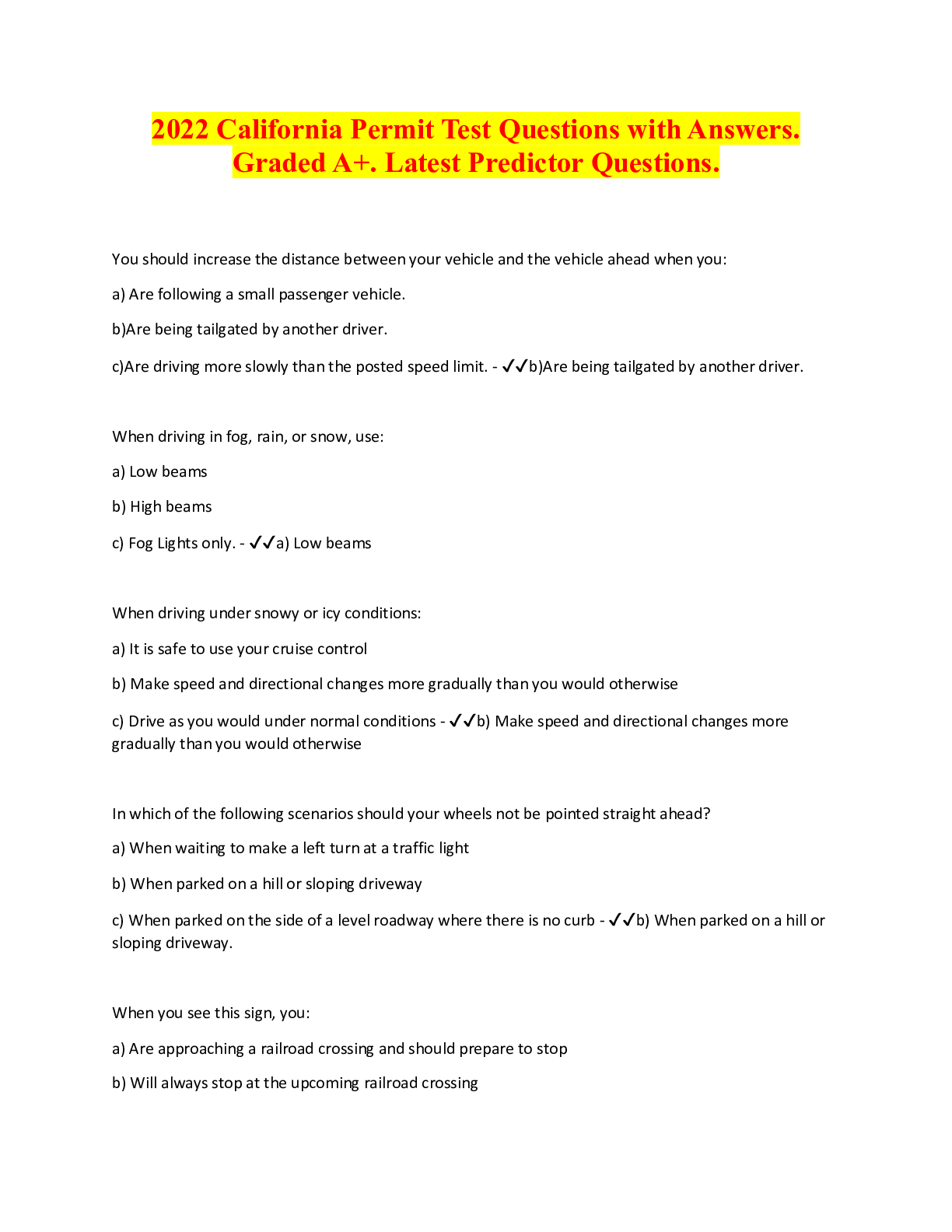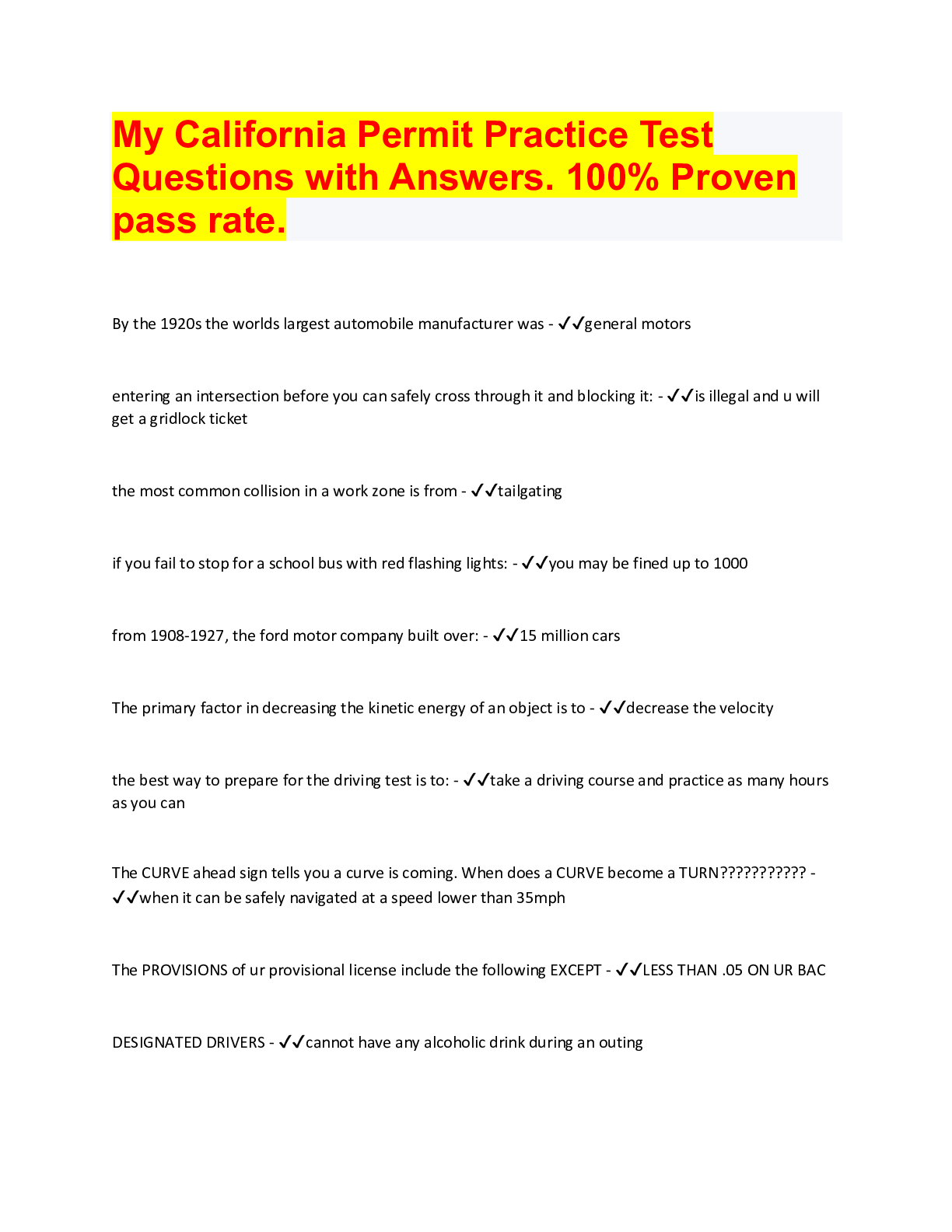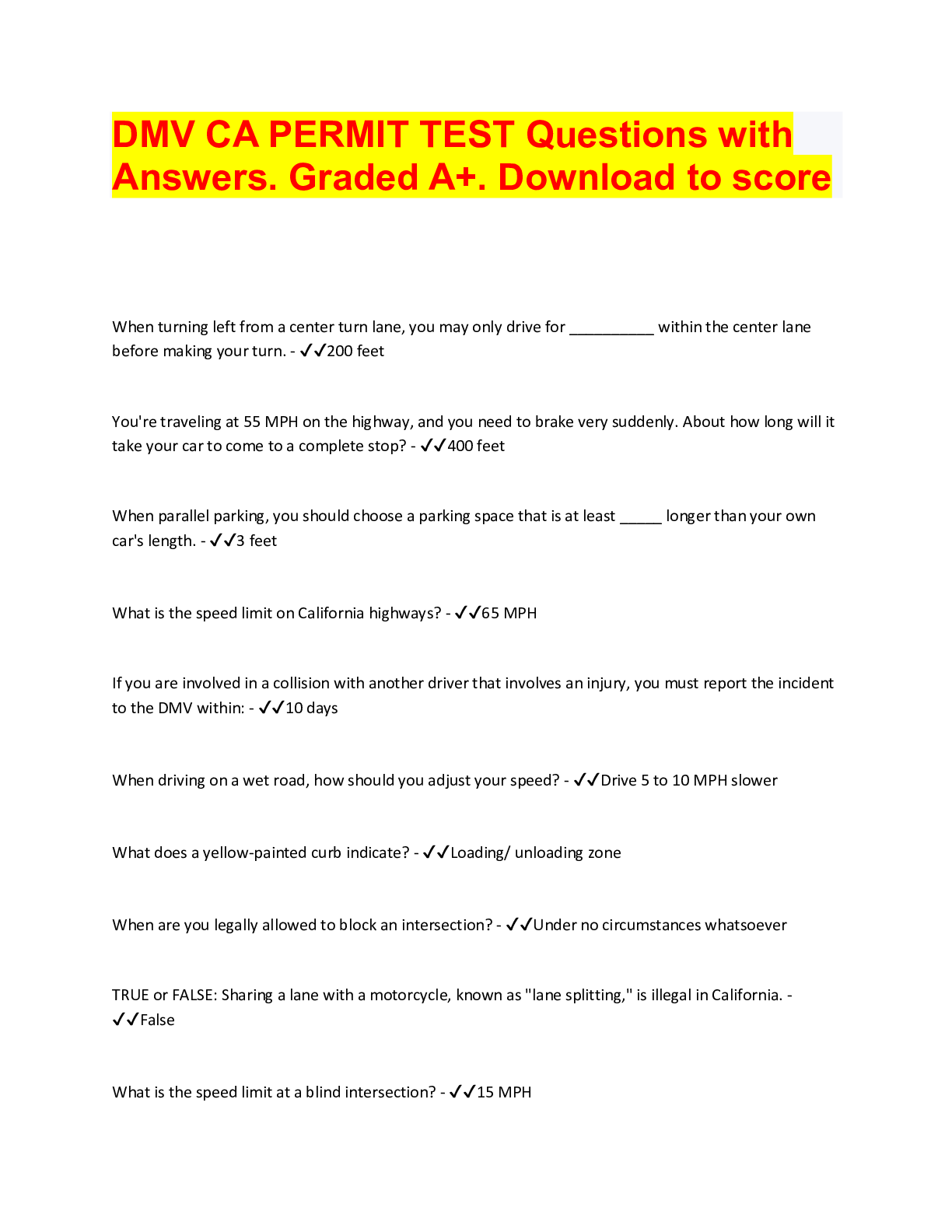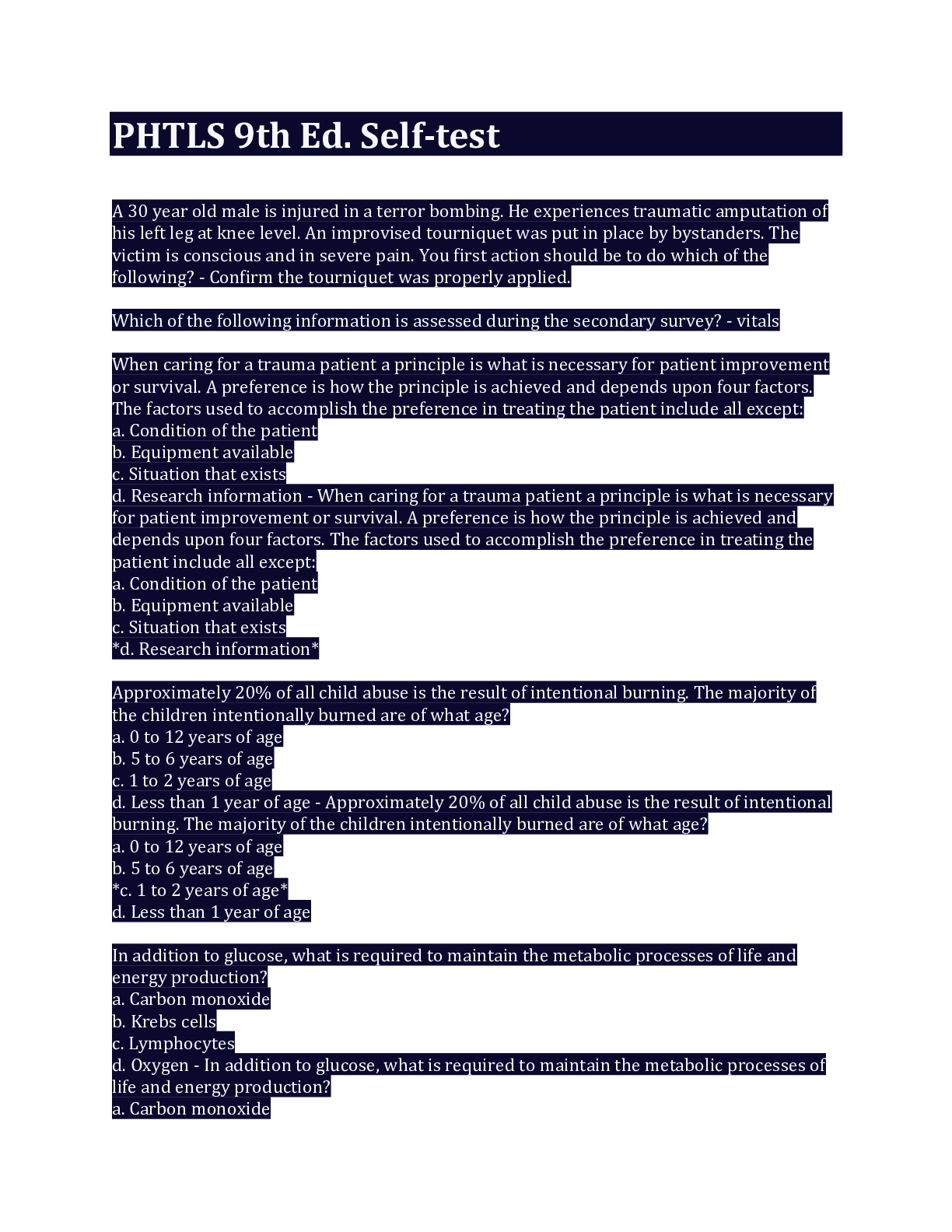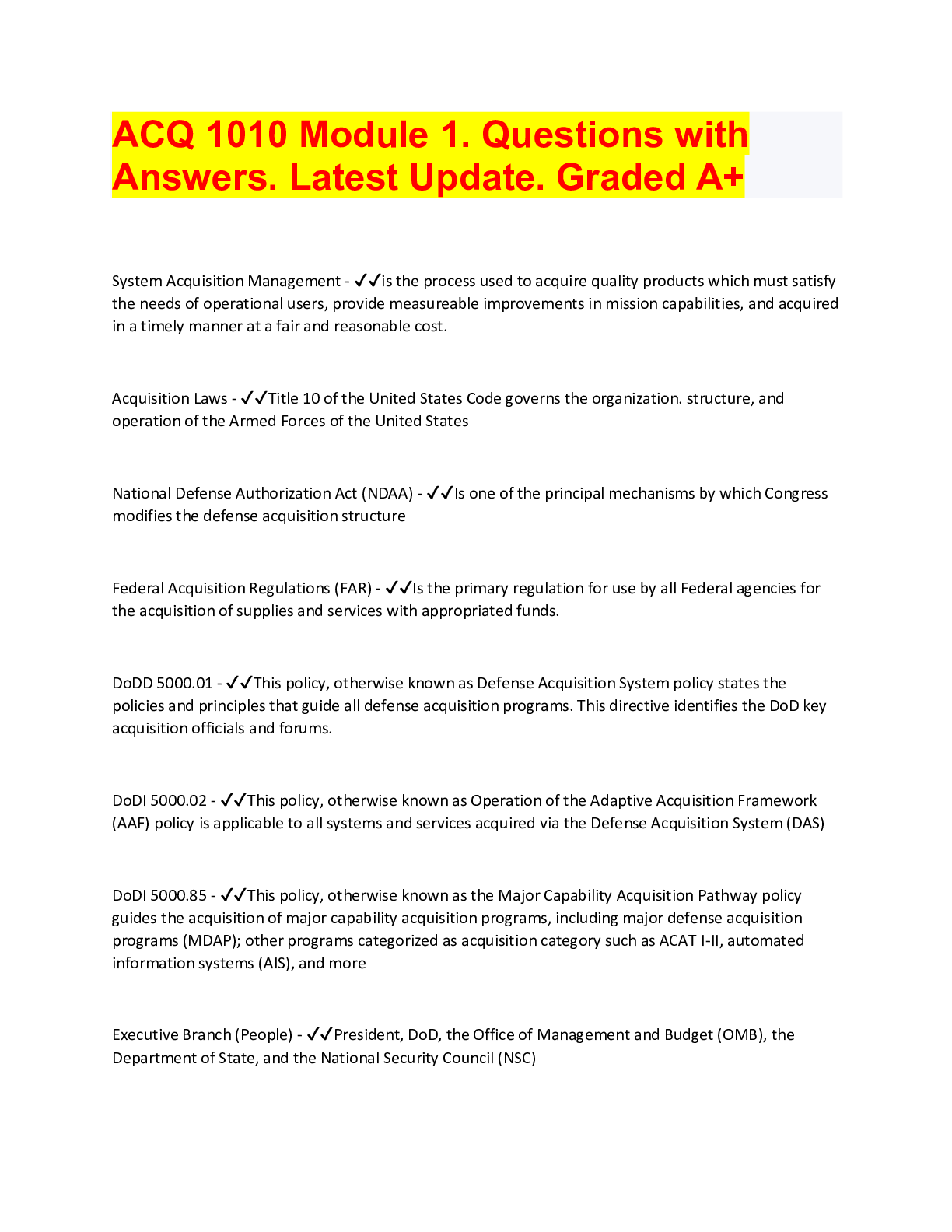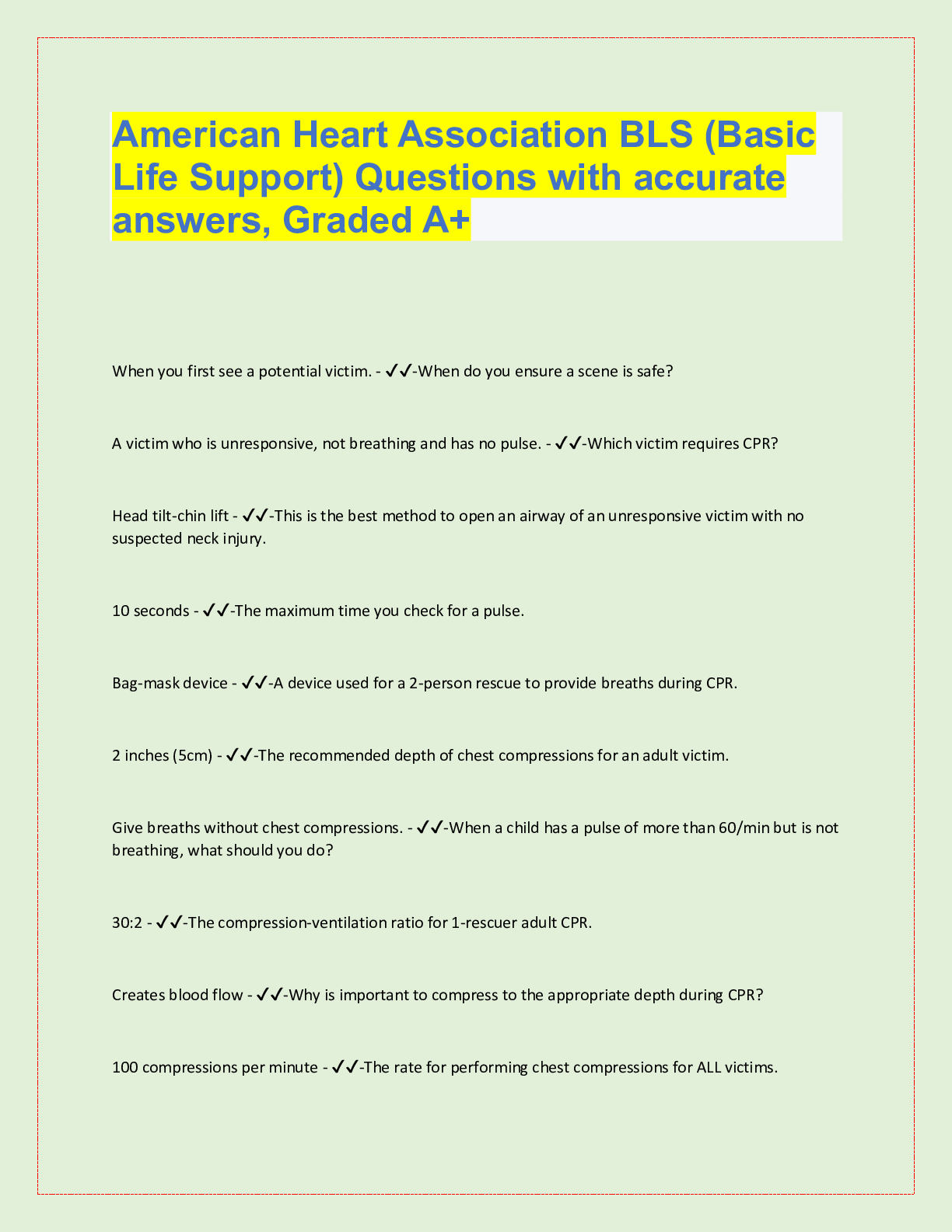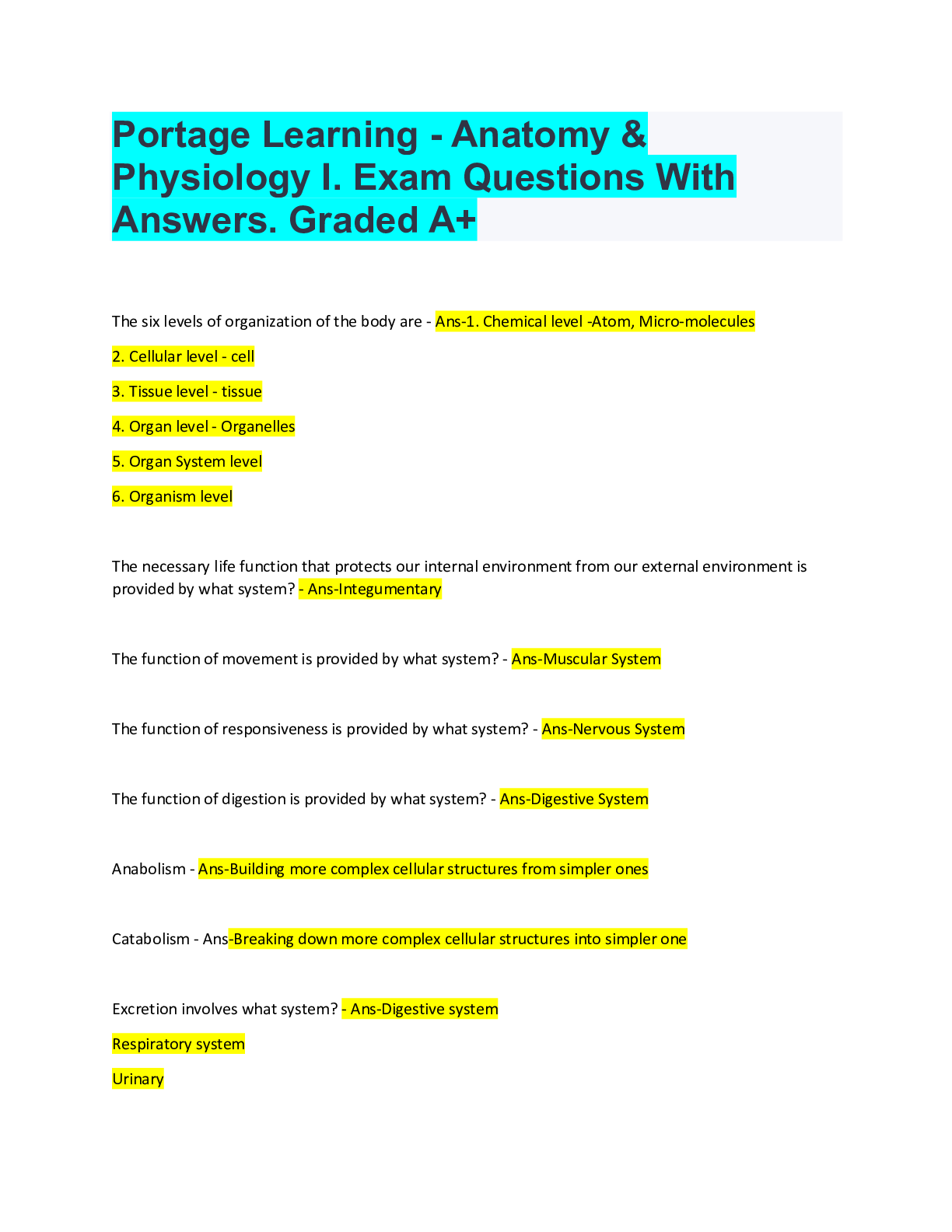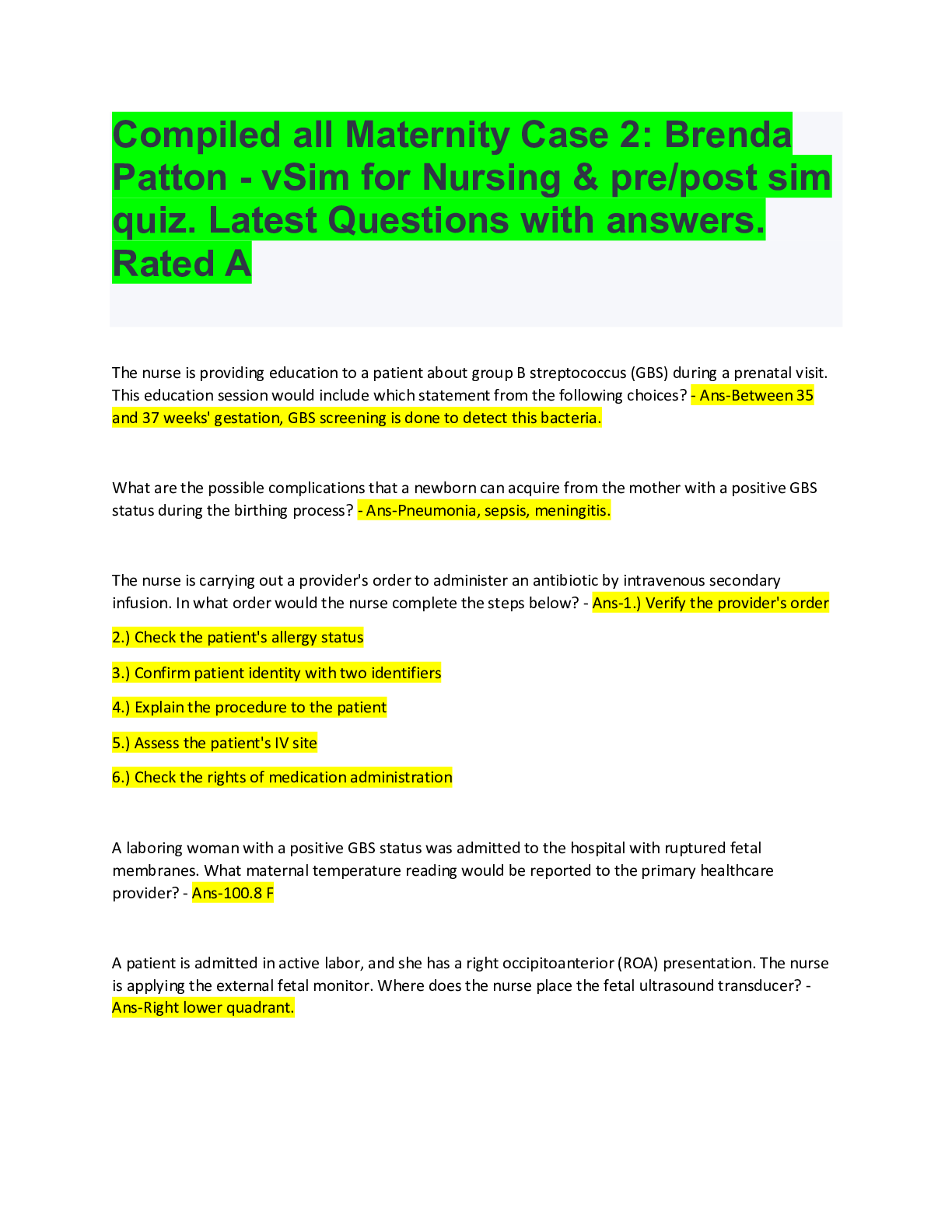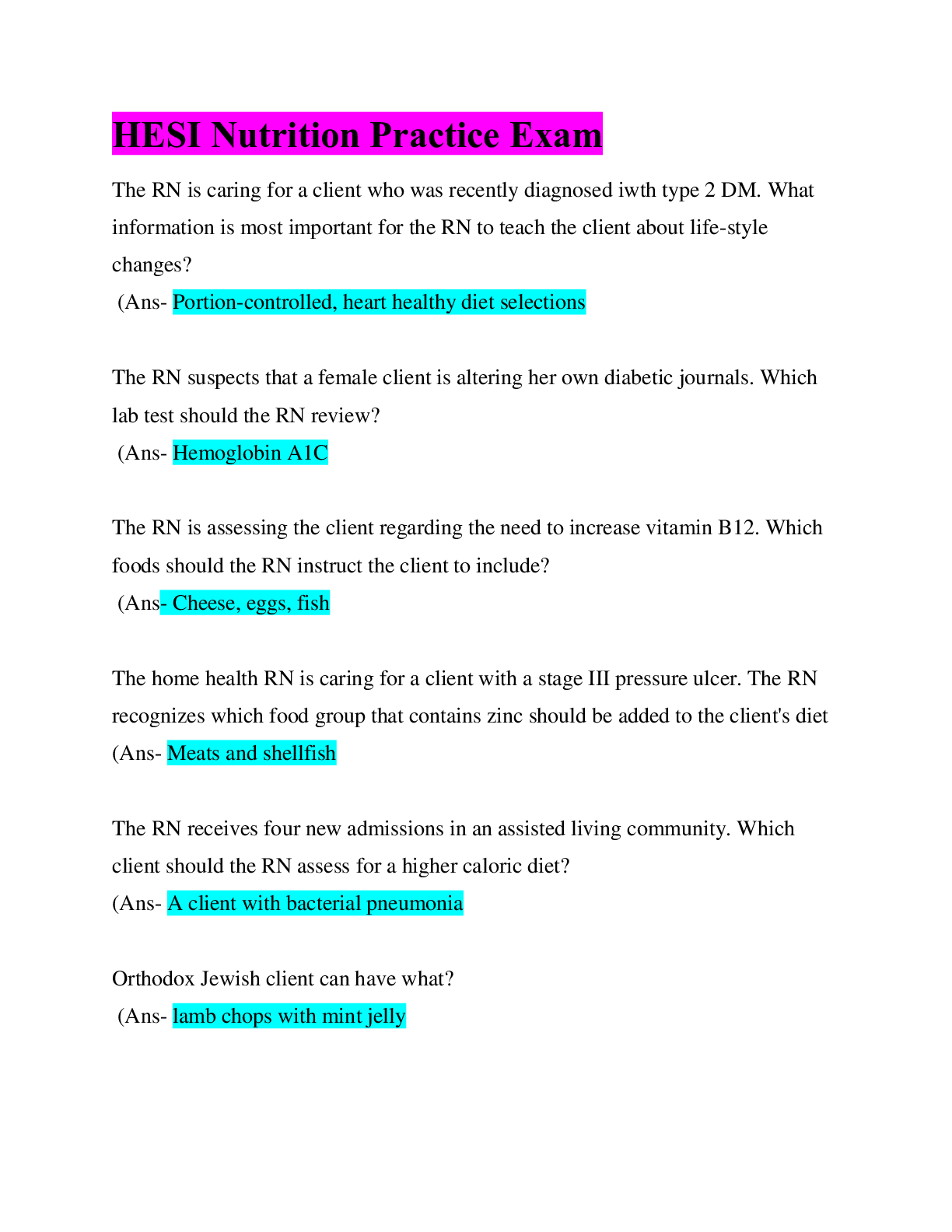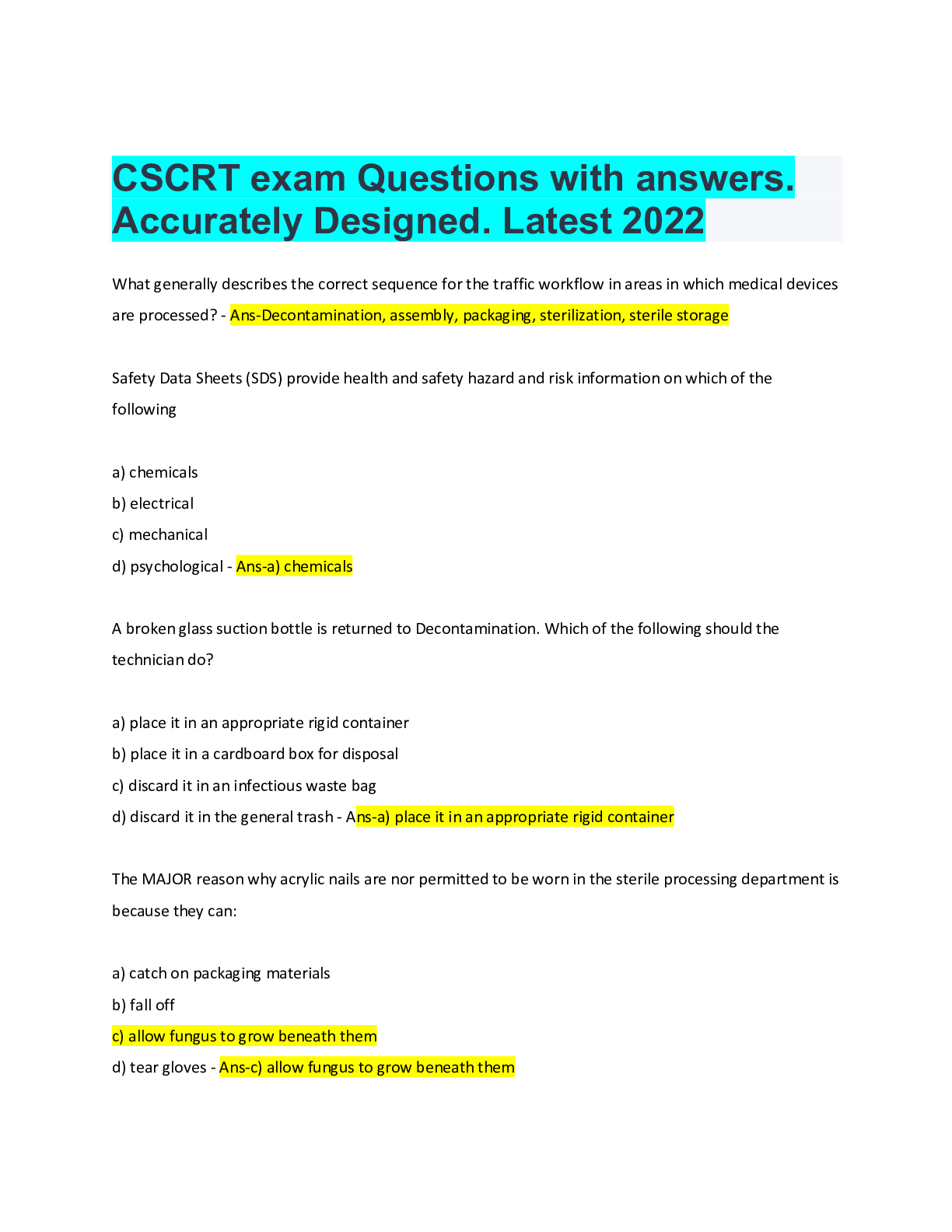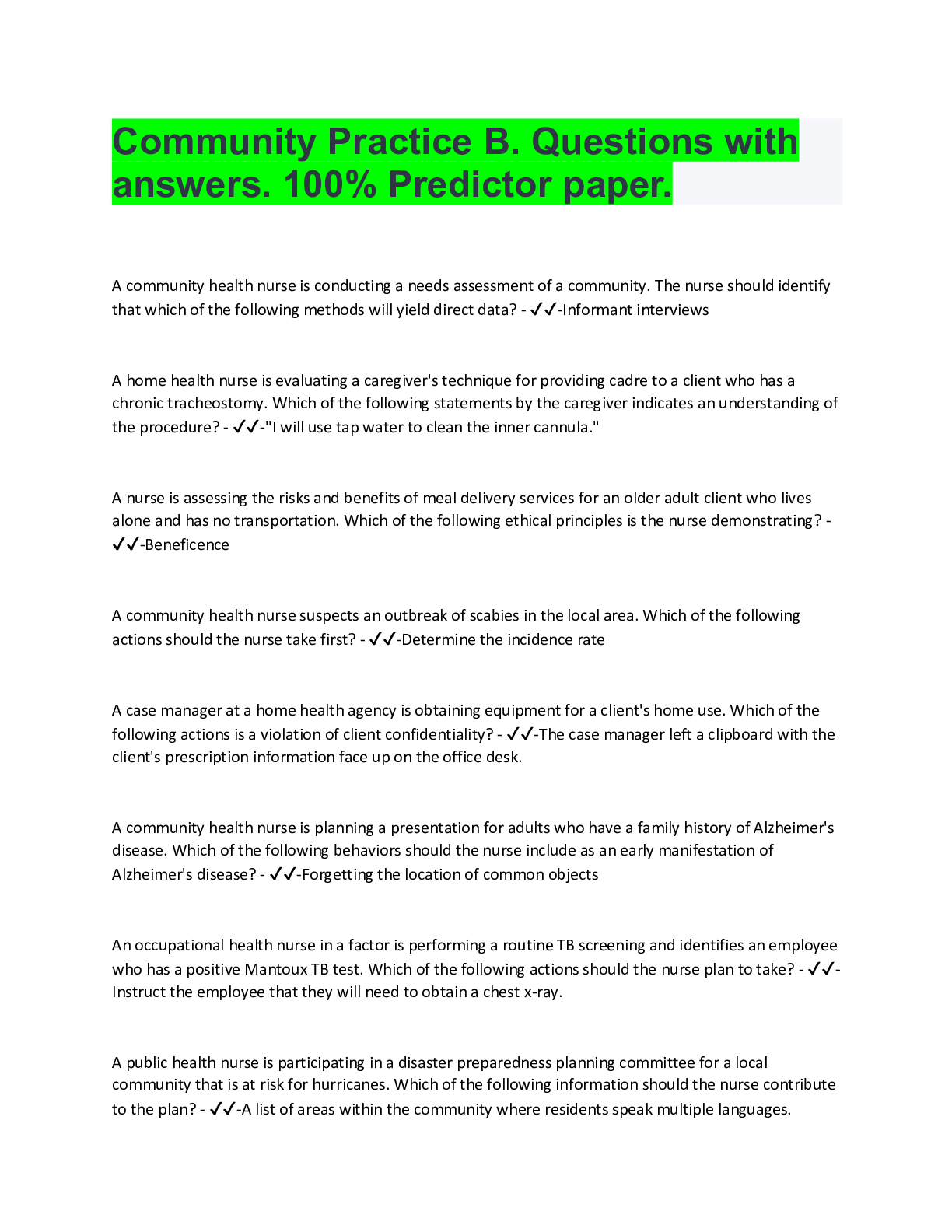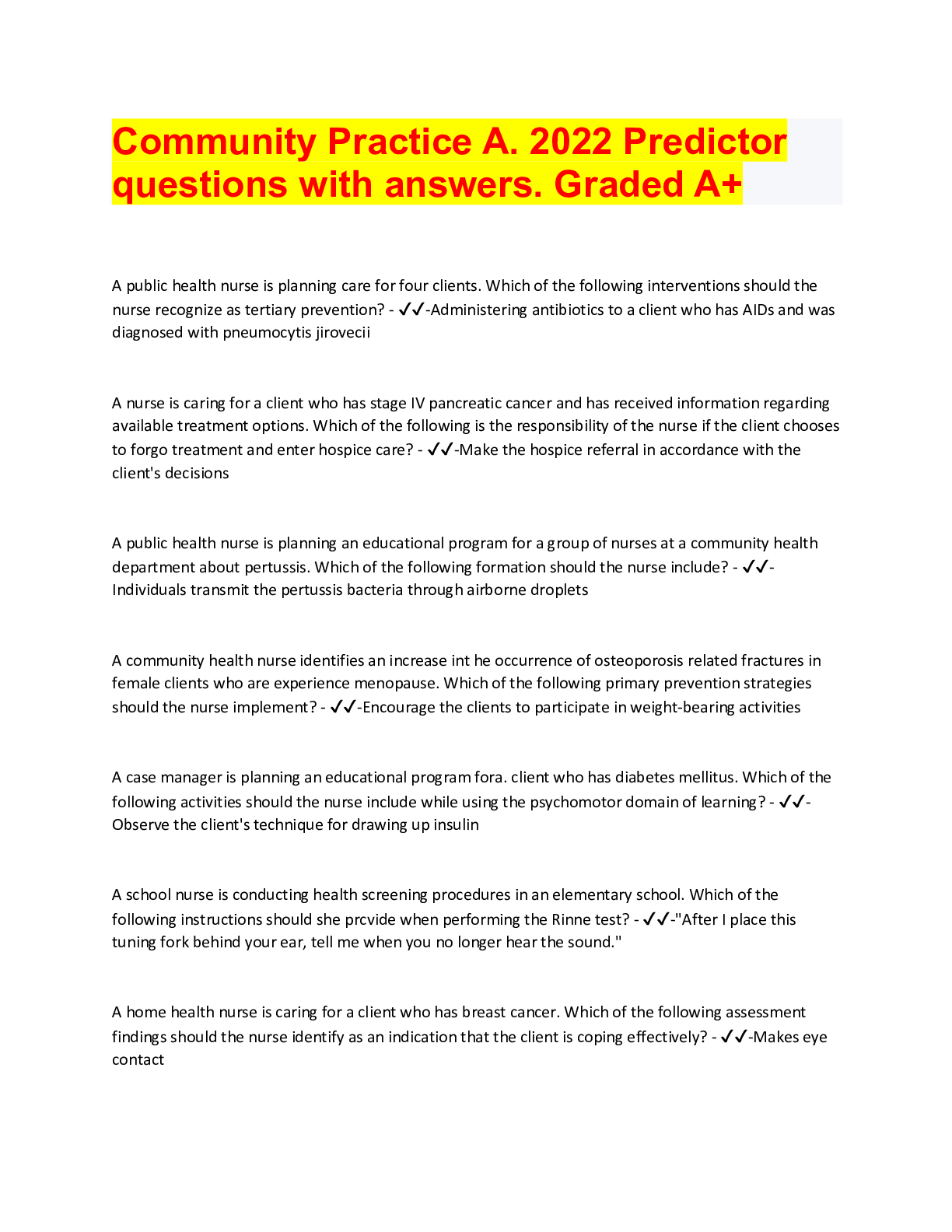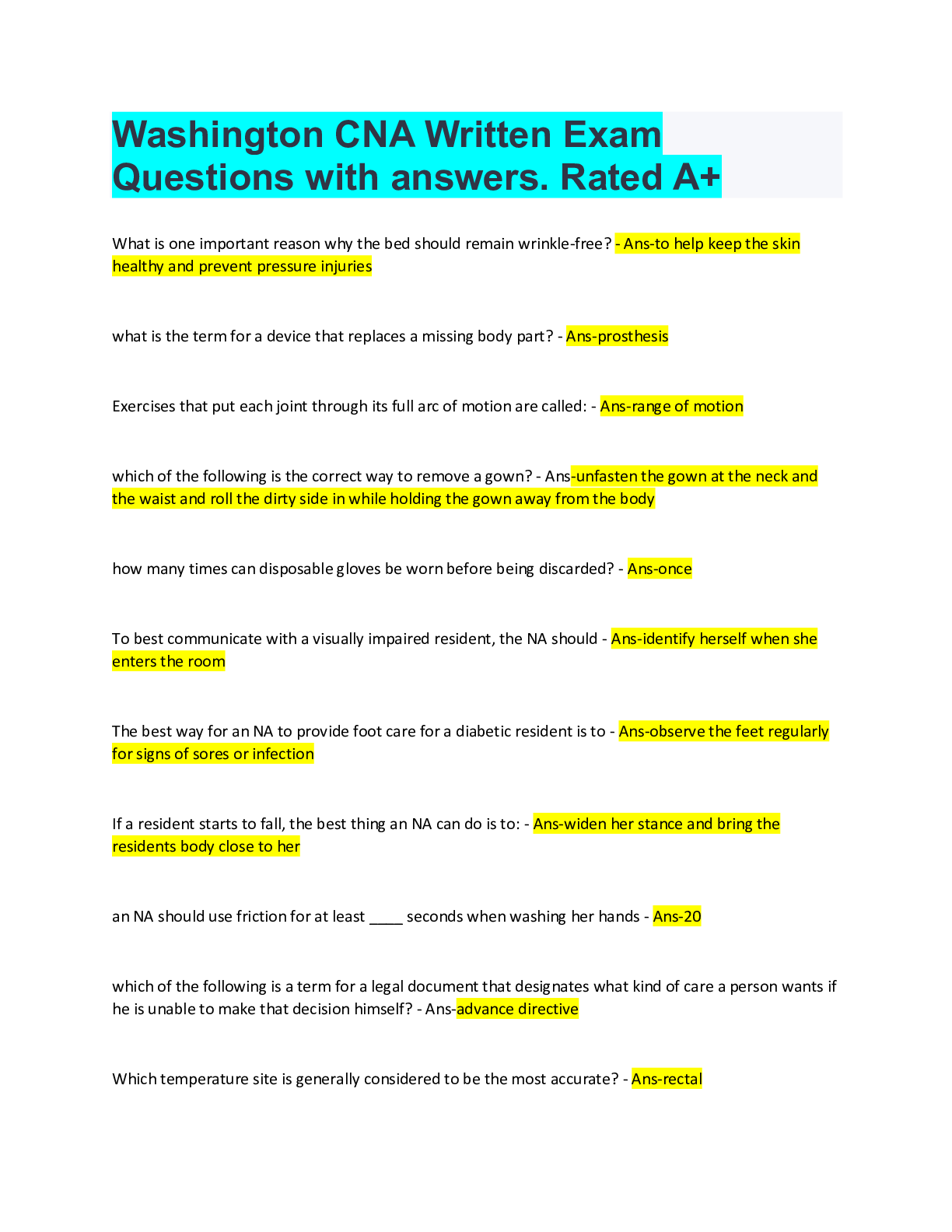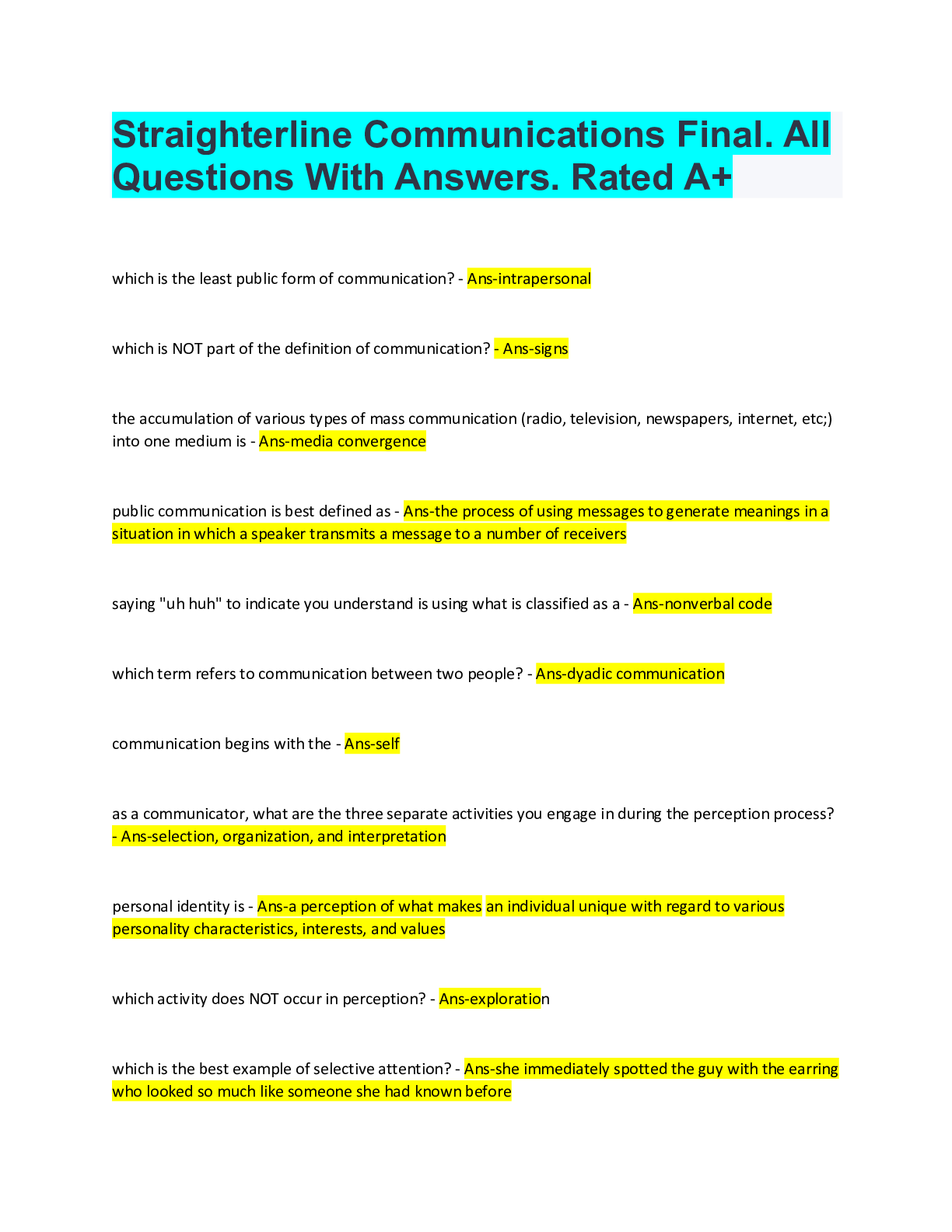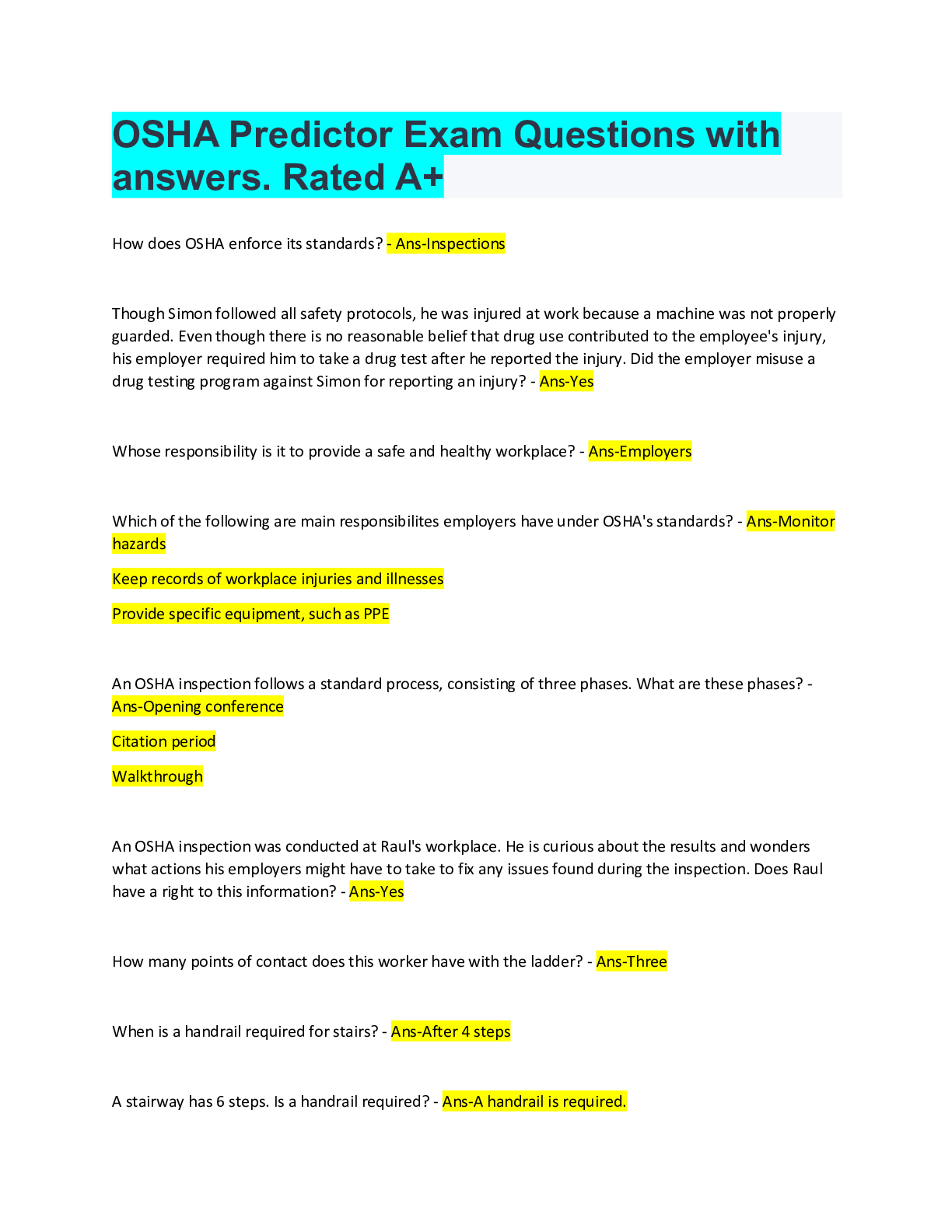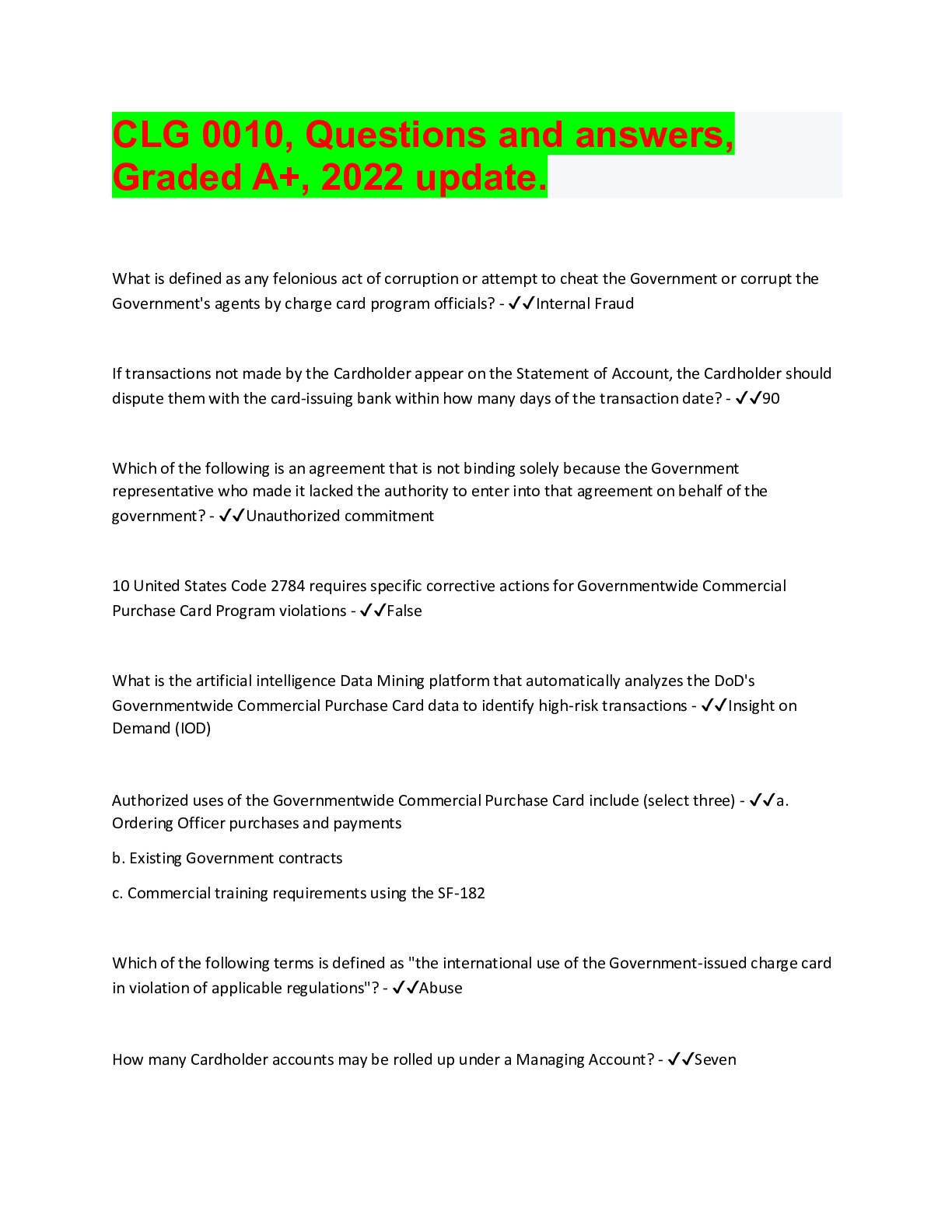*NURSING > QUESTIONS & ANSWERS > NASM Personal Trainer 2021, Guide Questions with answers. Rated A+ (All)
NASM Personal Trainer 2021, Guide Questions with answers. Rated A+
Document Content and Description Below
5 Phases of OPT Model - ✔☑-Stabilization Endurance -Strength Endurance - Muscular Development -Maximal Strength -Power Homeostasis - ✔☑Human body ability to respond to stress and make ... changes to maintain optimal health and physiological functioning. Acute Disease - ✔☑medical condition that occurs suddenly and can be treated an healed in a short period of time e.g. bronchitis. Left untreated bronchitis could become a chronic illness. Chronic Disease - ✔☑a medical condition that persists long term e.g. emphysema. Ischemic Heart Disease - ✔☑Narrowing of coronary arteries which supply blood and oxygen to the heart. Atherosclerosis - ✔☑Plaque is formed in the arteries, leading to reduced blood flow to the heart or brain. Hypertension - ✔☑Blood pressure greater than 120/80 (systolic/diastolic. Systolic blood pressure (SBP) - ✔☑Pressure in arteries and other blood vessels when the heart is beating or contracting. Top number recorded. Diastolic blood pressure (DBP) - ✔☑pressure in arteries and other blood vessels when the heart is at rest or between boots. Th bottom number recorded. Elevated Systolic between 120-129/80 Stage 1 Hypertension 130-139/80-89 Stage 2 Hypertension - 140+/90 Hypertension Crisis - Great than 180/120 - ✔☑ Cholesterol (Dyslipidemia) - ✔☑Waxy substance found in blood made up of protein and fatty acids known as lipoprotein. 2 types of Cholesterol - ✔☑Low-density lipoprotein (LDL) - bad cholesterol-plaque clogs arteries High density lipoprotein (HDL) - good cholesterol-doesn't clog arteries Diabetes - ✔☑Disease that impacts the body's ability to properly metabolize carbohydrates, specifically glucose. Two types of Diabetes - ✔☑Type 1 - genetic can't be prevented. Exercise helps. Type 2-body produces insulin, but not used properly by the cells. Insulin resistance (type 2 diabetes) - ✔☑The inability of the cells to respond to insulin. Cancer - ✔☑Abnormal cell growth in the body. Chronic Obstructive Pulmonary Disease (COPD) - ✔☑Respiratory dysfunctions that include breathlessness, airflow limitation, and decline of lung function. Patellar tendonitis - ✔☑Inflammation of the tendon that connects the patella (knee cap) to the tibia (shin bone). Anterior cruciate ligament (ACL) tear - ✔☑Stretch, partial or complete tear of the ligament of the knee. Medial cruciate ligament (MCL) tear - ✔☑Stretch, partial or complete tear of the medial collateral ligament of the knee. Shoulder impingement - ✔☑Shoulder pain caused by rotator cuff tissues rubbing against the acromion bone of the shoulder. SWOT analysis - ✔☑As a CPT you need to identify your personal strengths, weakness and opportunities for growth and potential threats to success. Four P's of Marketing - ✔☑product, price, promotion, place Unique Selling Product (USP) - ✔☑A set of specific skills or traits that are highlighted during a sales presentation (marketing to an older population or stay at home moms, etc.) Amotivation - ✔☑Not being engaged in an activity or behavior (not wanting to exercise). Extrinsic motivation - ✔☑Doing an activity for some form of recognition (win an award). Short term exercise as once reward is given person loses focus. Intrinsic motivation - ✔☑Pursuing activities that are of interest or meaningful to that person (long term exercise). Outcome goals - ✔☑Focused on the end result (place in top 10 in a 10K race). Process goals - ✔☑Process of pursuing a goal (walking 1 hour a day @ 11am Monday-Sunday). 4 types of social support - ✔☑Instrumental (driving one to the gym, watching their kids so they have time to workout); Emotional (encouraging showing empathy); Informational (providing education about fitness and health); and Companionship (accompanying friend to the gym) 4 Components of Leadership - ✔☑Leader's qualities (being optimistic, empathetic, and knowledgeable.; Leadership styles (encourages feedback and input from students); Situational Factors (factors such as large or small class); and Follower's qualities (age group, gender, and exercise level). 10 Benefits of group exercise - ✔☑Accountability, Comparison Competition Comradery Consistency Energy Intensity Mindless (know what to expect Motivation; and Sociability (warm and inviting) Third space - ✔☑A special communal space that is separate from work or home. A where one can build relationships with others e.g. the gym. SMART goals - ✔☑Specific, Measurable, Attainable, Realistic & Timely. Determinants of Behavior - ✔☑Psychological, social or environmental factors that influence behavior. Autonomous Motivation - ✔☑When client values the outcome and is motivated to exercise. Affective Judgment - ✔☑Expected pleasure or enjoyment. Subjective Norms - ✔☑Belief that an important person or group will approve and support a behavior e.g. resistance training. Stages of Change Model a/k/a Transtheoretical Model of Behavior Change. - ✔☑Precontemplation- individual doesn't exercise and is not planning to within the next 6 months. Contemplation-individual does not currently exercise, but plans to in the next 6 months. Preparation-Planning to begin exercise soon and maybe be sporadically exercising already. Action-Been exercising for at least 6 months. Maintenance-has been exercising consistently for 6 months or more. Decisional Balance - ✔☑Weighing the pros and cons of changing a behavior. Reflective Listening - ✔☑Understanding the meaning of the speaker's words and relaying back to the speaker of what that understood was correct. Active Listening - ✔☑Taking a genuine interest in what the speaker is saying and looking them in the eye while speaking. Closed Ended Questions - ✔☑Directive questions that can be answered with a one word answer yes or no. Open Ended Questions - ✔☑Non-directive questions that can't be answered by a simple yes or no. Require critical thinking before responding. Motivational Interviewing - ✔☑Instills feelings of being ready, willing, and able for the client to make a change in their behavior. Self-Discrepancy - ✔☑Internal conflict between what someone thinks their ideal self should be and what the actual self is. Sustain talk - ✔☑Keeping things the way they are and not wanting to make a change e.g. not wanting to make time to exercise by looking for excuses. Implementation intentions - ✔☑Connecting the exercise routine to a specific event (exercising during lunch break). Coping intentions - ✔☑Anticipating barriers and creating alternative plans to exercise. Reverse listing - ✔☑Replacing negative self talk with positive. Instrumental support - ✔☑tangible things such as assist someone with the ability to exercise e.g. providing transportation, child care, packing their gym bag. Human Movement System (HMS) - ✔☑The components and structures that work together to move the body (muscular, skeletal, and nervous system. Kinetic Chain - ✔☑The human body is a chain of interdependent links that work together to perform movement. Nervous system - ✔☑A network of nerves that transmits information within the human body. The nervous system provides sensory info. to our brain, stimulating human movement through muscle contractions, and keeping the heart and organs functioning. Neuron - ✔☑A specialized cell ; the functional unit of the nervous system They process and transit information through electrical and chemical signals. Nucleus - ✔☑Cellular structure or organelle that contains the majority of the cell's genetic material in the form of chromosomes. Organelles - ✔☑Tiny cellular structures that perform specific functions within a cell e.g. mitochondria. Mitochondria - ✔☑Parts of the cell that use nutrients to create energy for the cell (powerhouse of the cell). Effector sites - ✔☑A part of the body, such as a muscle or organ, that receives a signal from a neuron to produce a physiological response. Electrolytes - ✔☑Minerals that have an electrical charge and transmit nerve impulses within the body, such as sodium, potassium and magnesium. Central Nervous System (CNS) - ✔☑Nervous system that includes the brain and spinal cord. Peripheral Nervous System (PNS) - ✔☑Nerves that connect the rest of the body to the CNS. Afferent Pathway - ✔☑Sensory pathway that relays info. to the CNS. Efferent Pathway - ✔☑Motor pathway that relays info. from the CNS to the rest of the body. Interneurons - ✔☑Located within the spinal cord and brain that transmit impulses between afferent and efferent neurons. Mechanoreceptors - ✔☑Respond to mechanical forces (touch & pressure) within tissues and then transmit signals through sensory nerves. Somatic Nervous System (SNS) - ✔☑Nerves that serve the outer areas of the body and skeletal muscle and are largely responsible for the voluntary control of movement. Autonomic Nervous System (ANS) - ✔☑Supplies neural input to organs that run the involuntary processes of the body e.g. circulating blood, digesting food, producing hormones. Sympathetic Nervous System (SNS) - ✔☑Subdivision of the ANS that works to increase neural activity and put the body in a heightened state (releases adrenaline, increases heart rate, breathing and alertness during exercise). Parasympathetic Nervous System (PNS) - ✔☑The opposite effects of SNS to decrease neural activity by suspending release of excitatory hormones. This puts the body at a relaxed state (rest and digest). Sensory Function - ✔☑Ability of the nervous system to sense changes in either the internal or external environment Proprioception - ✔☑The body's ability to sense its general orientation and position of its parts e.g. shooting a basketball into a net. The body is trained to know to extend arms above head to focus on shooting the ball into the basket without having to look at the arms to accomplish this motion. Integrative Function of the CNS - ✔☑Analyze and interpret sensory info. to allow for proper decision making to produce an appropriate response. Motor Function - ✔☑The body's response to integrated sensory information e.g. causing a muscle to contract when stretched to far Muscle Spindles - ✔☑Sensory receptors sensitive to change in length of the muscle and the rate of that change. Stretch Reflex - ✔☑Neuro signal from the muscle spindle that causes a muscle to contract to prevent excessive lengthening. Golgi tendon organs - ✔☑Sensory receptors located at the point where skeletal muscle fibers insert into the tendons of skeletal muscle. They are sensitive to changes in muscular tension and rate of tension change (to avoid injury). Joint receptors - ✔☑They respond to pressure acceleration, and deceleration of the joint Neuroplasticity - ✔☑The brain will continually change or grow, reforming neural pathways throughout an individual's entire life span. Neurocircuitry - ✔☑Interconnection of neurons in the brain and spinal cord. Motor skills - ✔☑Coordinated movements of the muscles and limbs Skeletal system - ✔☑Provides the shape and form of our body, supports and protects internal organs, provides movement, produces blood and stores minerals. Osteoporosis - ✔☑A condition of reduced bone mineral density, which increases risk of bone fracture. Joints - ✔☑Where two bones meet and movement occurs as a result of muscle contraction. Axial skeleton - ✔☑Made up of the skull, rib cage, and vertebral column (80 bones) Appendicular Skeleton - ✔☑Made up of arms, legs, and pelvic girdle (126 bones) Levors - ✔☑Rigid rods where muscles attach. Remodeling - ✔☑The bone is constantly renewed by the resorption and formation of the bone structure. Osteoclasts - ✔☑Special cells that break down and remove old bone tissue. Osteoblasts - ✔☑Special cells that form and lay down new bone tissue. Wolff's law - ✔☑Scientific explanation of how remodeling occurs along the lines of stress placed on the bone e.g. walking or running). 5 types of bones - ✔☑Long Humerus (upper arm bone) ,Femur (thigh bone), Clavicle (collar-bone), radius and ulna (forearm bones), tibia and fibula (shin bones) , metacarpals and phalanges (finger and toe bones). Short (cubical shape) shock absorption; Carpals of the wrist; tarsals of the ankle. Flat Scapulae (shoulder blades, Sternum (breast plate), ribs, ilium (pelvis), and cranial (skull) bones. Irregular (vertebrae-spinal column; sacrum, coccyx (tailbone) and certain facial bones). Sesamoid (small round-kneecap) also found in hands and feet and improve leverage and protect the joint from damage. Depression Bones (Fossa & Sulcus (groove in a bone) - ✔☑Flattened or indented portions of the bone. Processes - ✔☑Projections protruding from the bone to which tendons and ligaments can attach. Vertebral Column (Spinal Column) - ✔☑Bones that house the spinal cord consisting of cervical (C 1-C7), Thoracic (T1-12), Lumbar (L1-L5) and Sacrum (S1-S5 fused), Coccyx Spinal Cord - ✔☑Bundle of nerves housed within the vertebrae. Intervertebral Discs - ✔☑Made of fibrous cartilage that acts as shock absorbers and allow spine to move. Neural Spine - ✔☑Represents a position in which the vertebrae and associated structures are under the least amount of load and support optimal functional movement. 3 Major Curvatures of he Spine - ✔☑Concave (cervical curve, hollowed or rounded inward). Convex (thoracic curve, curved and rounded outward). Concave (lumbar curve, hollowed or rounded inward). Osteokinematics - ✔☑Bone movement (flexion and extension) Arthrokinematics - ✔☑Joint movement interaction between two bone surfaces. Roll, slide and spin. Synovial joints - ✔☑Compromise 80% of all joints in the body and have the greatest capacity for motion and produce synovial fluid which lubricates and provides nutrition for the joints. There are several types of synovial joints including glide, condyloid, hinge, saddle, pivot, and ball and socket joints. Non-synovial joints - ✔☑Have no joint capsule and exhibit little to no movement (sutures of the skull). Nonaxial joint - ✔☑Gliding joint has the simplest movement of all joints. It moves back and forth or side to side. (movement in one direction ex: carpal bones of the wrist and joints of the fingers). Hinge Joint - ✔☑Uniaxial joint allowing movement in one direction (elbow, toe, and ankle). Pivot Joints - ✔☑Allow movement in one direction. Found at the base of the skull (top of the spine) and the elbow. Ball & Socket - ✔☑Most mobile of all joints. Allow movement in 3 directions (shoulder and hip). Ligaments - ✔☑Fibrous connective tissue that connects bone to bone. Made up of protein called collagen (provides strength and structure to connective tissue, muscles and skin) and elastin (provides elasticity to skin, tendons, and ligaments). Tendons - ✔☑Connect muscle to bone. Skeletal muscle - ✔☑Made up of individual fibers held together by connective tissues. Primary functions are to contract and produce movement Fascia - ✔☑Connective tissue that surrounds muscles and bones. Epimysium - ✔☑Inner layer of fascia that surrounds and entire muscle a/k/a deep fascia. Fascicles - ✔☑Largest bundles of fibers within a muscle. Perimysium - ✔☑Connective tissue surrounding a muscle Fascicle. [Show More]
Last updated: 1 year ago
Preview 1 out of 44 pages
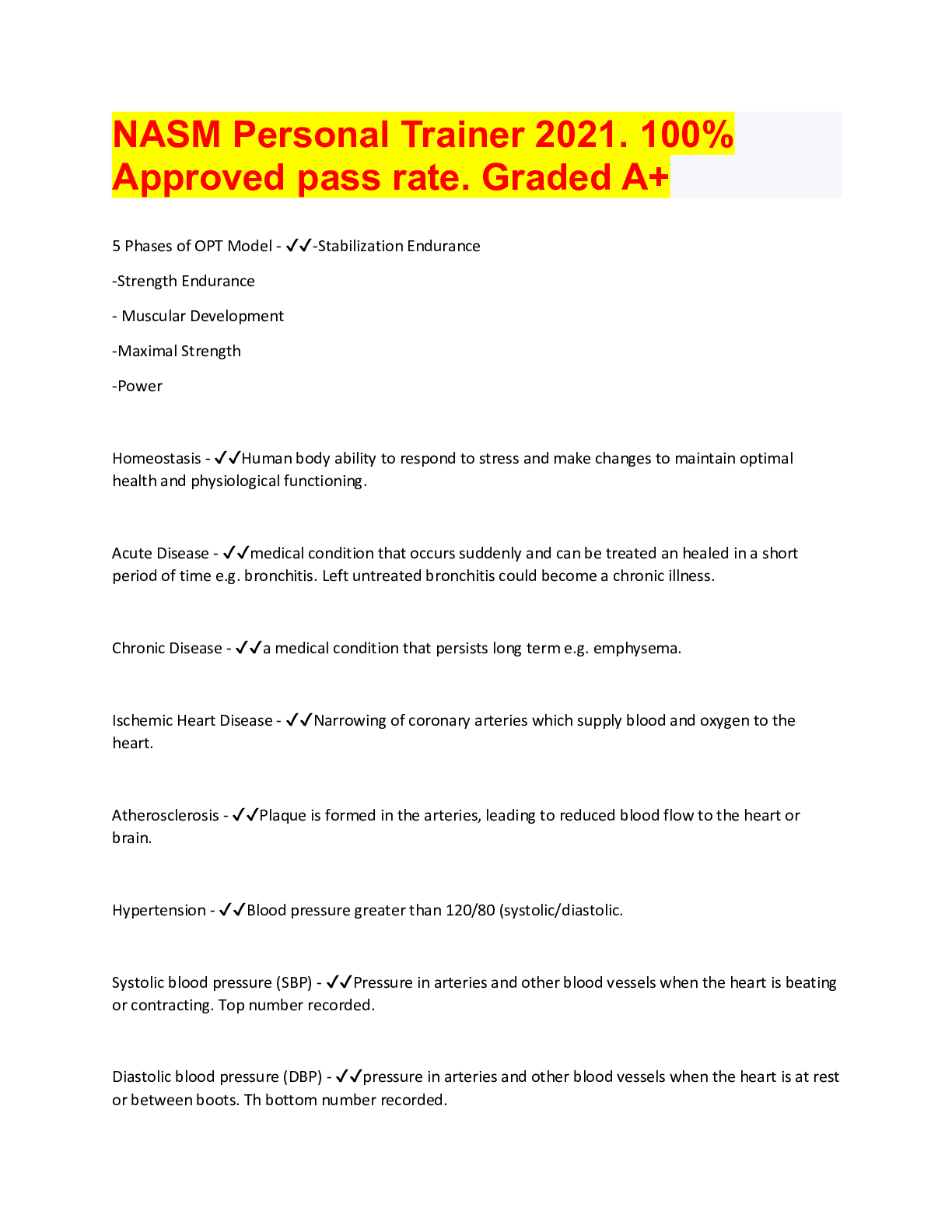
Reviews( 0 )
Document information
Connected school, study & course
About the document
Uploaded On
Aug 12, 2022
Number of pages
44
Written in
Additional information
This document has been written for:
Uploaded
Aug 12, 2022
Downloads
0
Views
69




